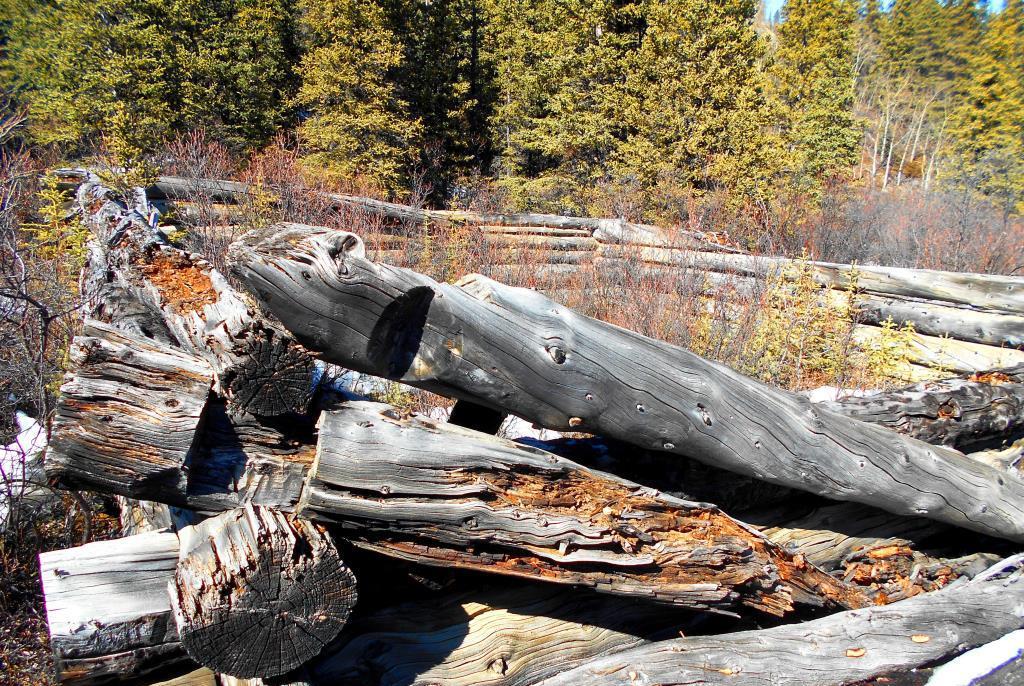
(Gord Allison photo)
A few years ago I put out an article on the Kluane Wagon Road in the southwest Yukon, which led to researching the roadhouses along the road as well as routes connected to it. Archival information about these roadhouses is relatively sparse, but local knowledge and on-the-ground work have helped me to document the existence of 15 of them.
The roadhouse operations provided travellers with food and sleeping accommodation, stables and feed for horses, and respite from harsh weather. In the early days especially, they played an important role in the safety and well-being of people in an unfamiliar and wild region of the Yukon.
The first roadhouses were built on the heels of a small gold rush initiated by discoveries on creeks in the southwest Yukon in the summer of 1903. They served the miners, freighters and other travellers that entered the Kluane region, primarily from Whitehorse. The mining activity declined within a couple of years, causing most roadhouses to be relatively short-lived.
Some roadhouses had a short revival during the 1913 Chisana gold rush just over the border in Alaska, for which the wagon road was one of the main access routes. Other roadhouses were established at this time along a connected winter road that was built to Cultus Bay on Kluane Lake to support this gold rush.
Almost all of these roadhouses were abandoned after a couple of years of service, but the ones at Champagne and Bear Creek persisted more or less continually into the coming of the Alaska Highway era that began in 1942. Some of the abandoned roadhouses continued to be used by travellers until too badly deteriorated.
There is no evidence left of most of the roadhouses now, but the remnants of the few that still exist are reminders of the hard work and aspirations of their builders and operators. Except for a few sites, the human stories associated with running these roadhouses are unfortunately lacking after almost 120 years.
The 15 roadhouses were established along three related routes: a First Nations foot trail into the region from the Whitehorse area; the Kluane Wagon Road itself, which followed much of the foot trail; and a winter road that was built off of the Kluane Wagon Road a few years later. These routes will be examined in more detail in the next section.
The following table shows the roadhouses on the original trail and/or Kluane Wagon Road, and on the Kluane winter road, with their known or surmised dates of establishment. The available information and research will look at all these individually in the sections to follow.
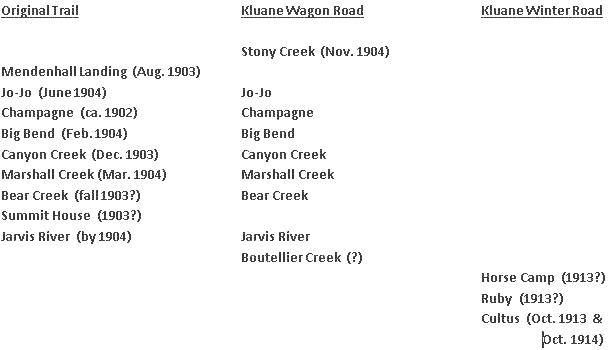
(Coming from Whitehorse, there were also three known roadhouses on the stretch of Overland Trail before the start of the Kluane Wagon Road was reached.)
The Routes
The following explanations and descriptions of the routes involved are to provide locational and historical context for the roadhouses described in the later section. The map below shows the general area covered by these routes, from the starting point of the Kluane Wagon Road northwest of Whitehorse, to Kluane Lake.
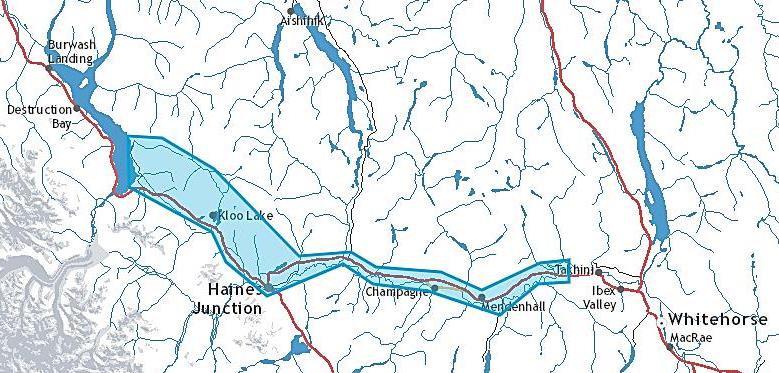
(GeoYukon viewer)
The Original Trail
The First Nation foot trail, one of many in a network of such trails, provided the initial access into the Kluane region following the discovery of gold. It was upgraded over the summer and fall of 1903 to enable some limited use by horses and wagons to the gold creeks in the Kloo Lake area. Most of the early roadhouses were established along this trail.
There is no map of the original trail, but much of it is believed to have been followed by the Kluane Wagon Road when it was constructed in 1904. There are some places where this did not happen, however, and a map from 1904 geological fieldwork by R.G. McConnell of the Geological Survey of Canada shows one such section. This deviation from the trail started at the Bear Creek roadhouse, located six miles northwest of present-day Haines Junction.
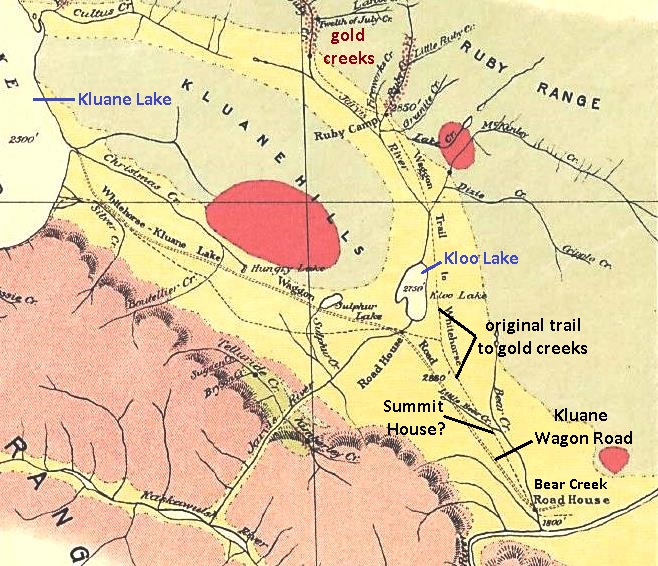
(from Geological Survey of Canada: Sketch map of Kluane Mining District, Yukon Territory, #894, R.G. McConnell, 1904)
While the trail followed a northerly course along the west side of Bear Creek and the east side of Kloo Lake toward the gold mining creeks, the wagon road took a slightly more northwesterly direction. It passed over the Bear Creek summit about a mile and a half west of the trail and at a higher elevation, and upon reaching the Jarvis River turned westward toward Kluane Lake. This had the effect of bypassing a probable roadhouse (using the term broadly) that was located on the trail.
This piece of original trail may have continued to be used on occasion, perhaps in different seasons and/or to access different parts of the Kloo Lake area. A book about a 1914 big game hunting trip in the region describes following “a course parallel to the noisy Bear Creek”. This could not have been the Kluane Wagon Road, which is far removed from the creek other than where it crosses it at the Bear Creek roadhouse. The hunting party had to have been using the trail, which follows along a high bank on the west side of Bear Creek, from where the sounds of the creek are very audible.
Kluane Wagon Road
In the fall of 1904 the Kluane Wagon Road was built, following many sections of the original trail, to provide improved access for horse-drawn wagons. Most of the early roadhouses ended up being located on or near the Kluane Wagon Road, perhaps their existence being a factor in the road’s route planning.
The Kluane Wagon Road branched off from the Dawson-Whitehorse Overland Trail, which had been constructed in 1902, at a point about 32 miles northwest of Whitehorse. It was built westward along the Takhini and Dezadeash River valleys and then northwest over the Bear Creek summit to Silver City on Kluane Lake. The total distance to Silver City from Whitehorse, the transportation hub and supply center for the southern Yukon, was 148 miles. (A previous article on the Kluane Wagon Road can be found at Kluane Wagon Road.)
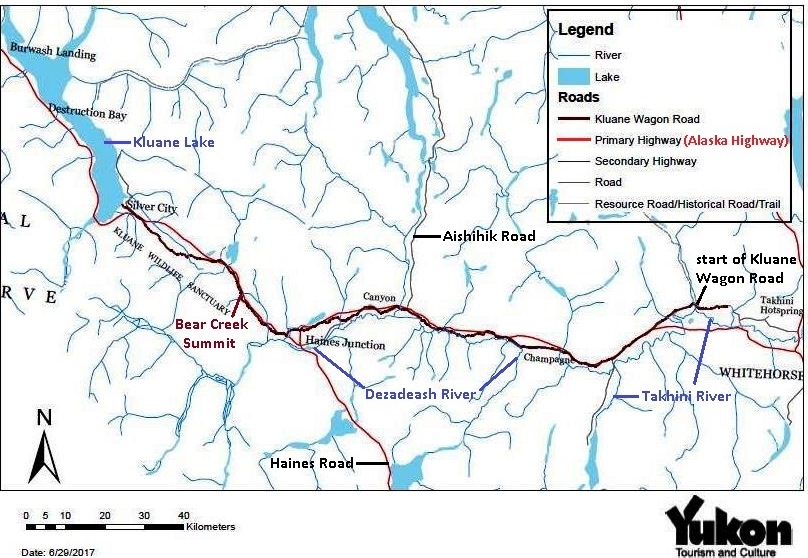
(Yukon Government, Dept. of Tourism & Culture, Historic Sites, 2017)
A description of the new Kluane Wagon Road was included in the North-West Mounted Police annual report for 1904: “this new trail has been well and carefully located, and as the country is naturally an easy one in which to build a trail, as might be expected the trail is good, all creeks, rivers and deep gullies being well bridged, and hills, of which there are uncommonly few, considering the length of the trail, are graded with easy ascents”.
While many other roads of the early 1900s, including the Dawson-Whitehorse Overland Trail, were only used in the winter, the Kluane Wagon Road could be travelled most of the year due to the topography and relative dryness of the country it passed through. However, most heavy freighting, particularly for mining activities, was undertaken when the ground was frozen.
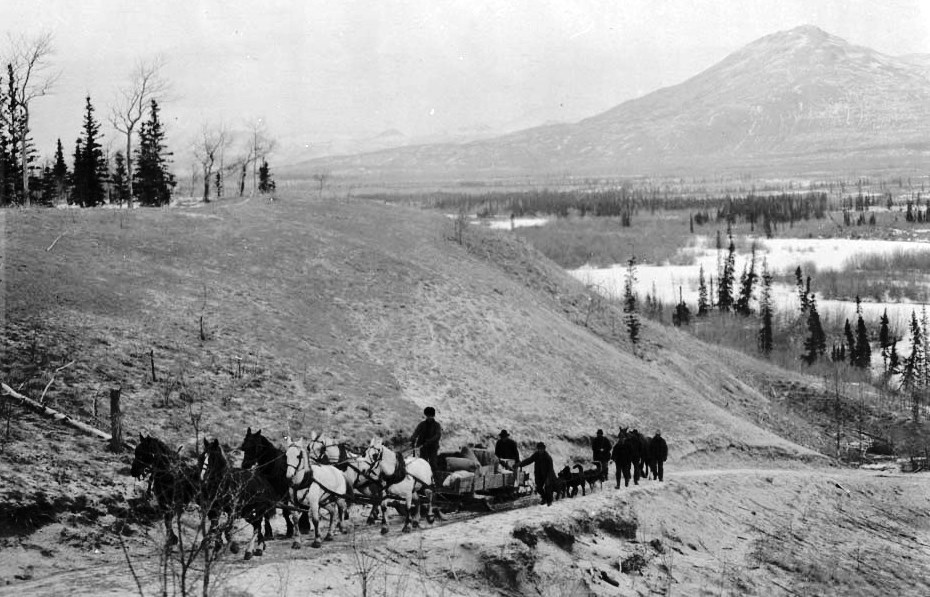
(Library & Archives Canada, #PA-044645)
From the Kluane Wagon Road’s beginning in 1904 to its end in 1942, the route for the first 68 miles remained constant. This was from the road’s starting point at the Dawson-Whitehorse Overland Trail westward to Marshall Creek, about 10 miles east of present-day Haines Junction. West from the Marshall Creek area, other trails and roads connected with the wagon road for various purposes.
At a point less than a mile east of Marshall Creek and north of the Dezadeash River, the Kluane Wagon Road split into two routes, one for summer use and the other for winter, until coming back together near Bear Creek. This information came from two late Champagne & Aishihik First Nations elders, Moose Jackson and Marge Jackson. This is the only known section of the wagon road where there were separate routes based on season.
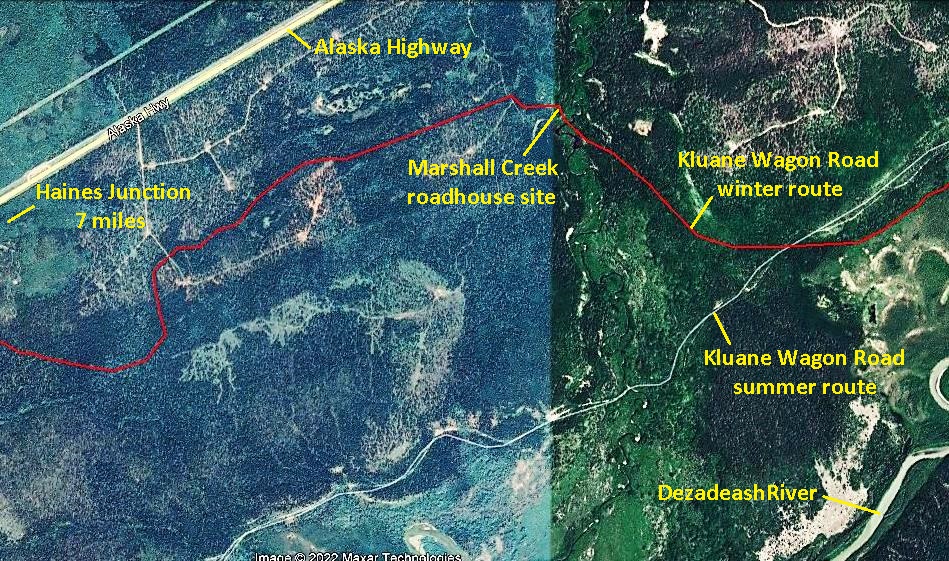
(Google Earth)
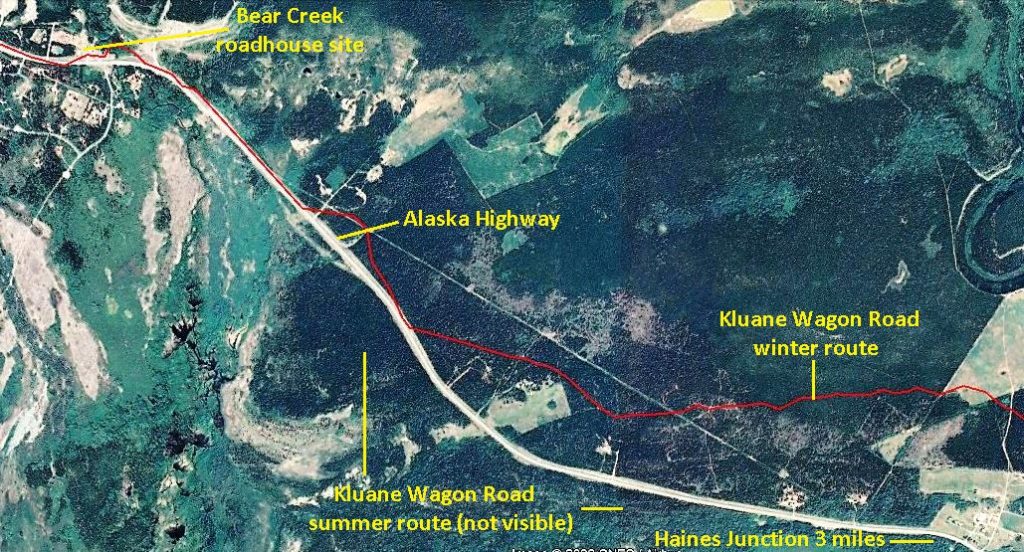
(Google Earth)
The 14-mile winter route went north from the Dezadeash River and up the Marshall Creek valley about a mile before crossing the creek and heading west. This was made clear by Marge Jackson, who said that the Marshall Creek roadhouse, which she played in as a child when her family camped in the area, was on the winter route of the wagon road.
The 15-mile summer route stayed closer and more or less parallel to the Dezadeash River, passing through the future site of Haines Junction before rejoining the winter route near Bear Creek. Early photos by Whitehorse photographer E.J. Hamacher and others show travel on this route in the valley bottom lands along the river. There were no roadhouses established along this summer route.
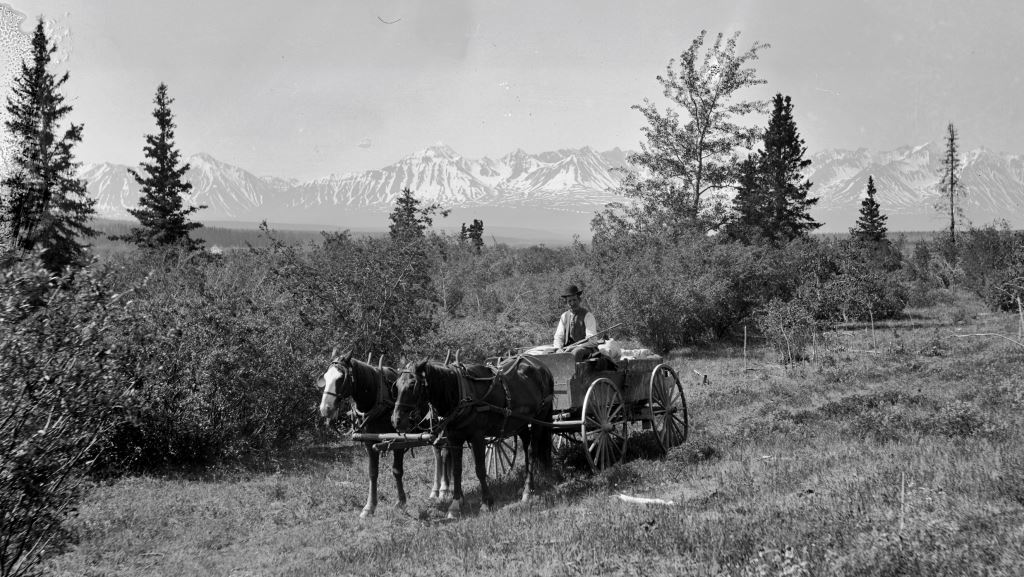
(Yukon Archives, E.J. Hamacher fonds (Hougen collection), Acc. 2002/118, #377 – photo has been cropped)
In 1915 the Dominion Land Surveyor H.G. Dickson surveyed most of the Kluane Wagon Road. For the section of the road between Marshall Creek and Bear Creek, he surveyed the winter route, indicating it was the one most commonly used.
Kluane Winter Road
In 1908 a beautiful hand-drawn sketch map titled “Diversion of Whitehorse-Kluane Road” was produced by H.G. (Harry) Dickson, a Dominion Lands Surveyor who had done all of the legal surveying in the Kluane region. It shows a road branching from the Kluane Wagon Road at Marshall Creek and going northwestward to the creeks east and north of Kloo Lake. It carries on via the Jarvis River and Cultus Creek valleys and onto the surface of Kluane Lake. There is no information or context accompanying this sketch.
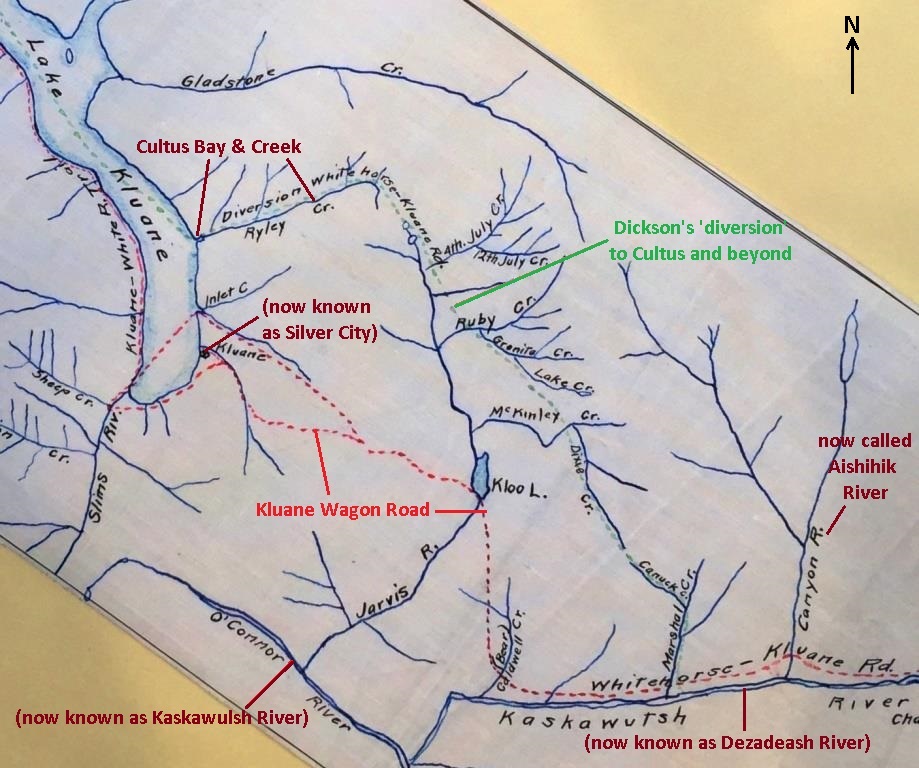
(Yukon Archives, Map H-86)
The country between upper Marshall Creek and the area east of Kloo Lake is quite hilly, much of it above timberline, and would be difficult to travel by horses pulling loaded wagons or sleighs. Dickson’s ‘diversion’ was likely a proposed route when it was sketched and the section between Marshall Creek and Kloo Lake never came to be, but it requires mentioning here in case future research indicates otherwise.
The diversion also needs mentioning for another reason. Over the following winter of 1908-09, Harry Chambers of Champagne built a new 50+-mile long winter road that branched from the Kluane Wagon Road near Marshall Creek and went to the Kloo Lake area and on to Cultus Bay on Kluane Lake. It seems probable that Dickson’s sketched diversion and Chambers’ road were part of the same overall plan, but the actual work did not totally adhere to what was proposed.
The route of Chambers’ winter road isn’t known with certainty, but an indication is found in a 1914 map produced by geologist D.D. Cairnes of the Geological Survey of Canada. It shows a winter road (in red ‘+’ symbols) starting from a point between Canyon and Marshall Creek and heading westward and then northwestward through the broad Shakwak Valley that contains Haines Junction and Kloo Lake. North of Kloo Lake it followed the more confined upper Jarvis River valley and then the very narrow Cultus Creek valley westerly to Cultus Bay on Kluane Lake.
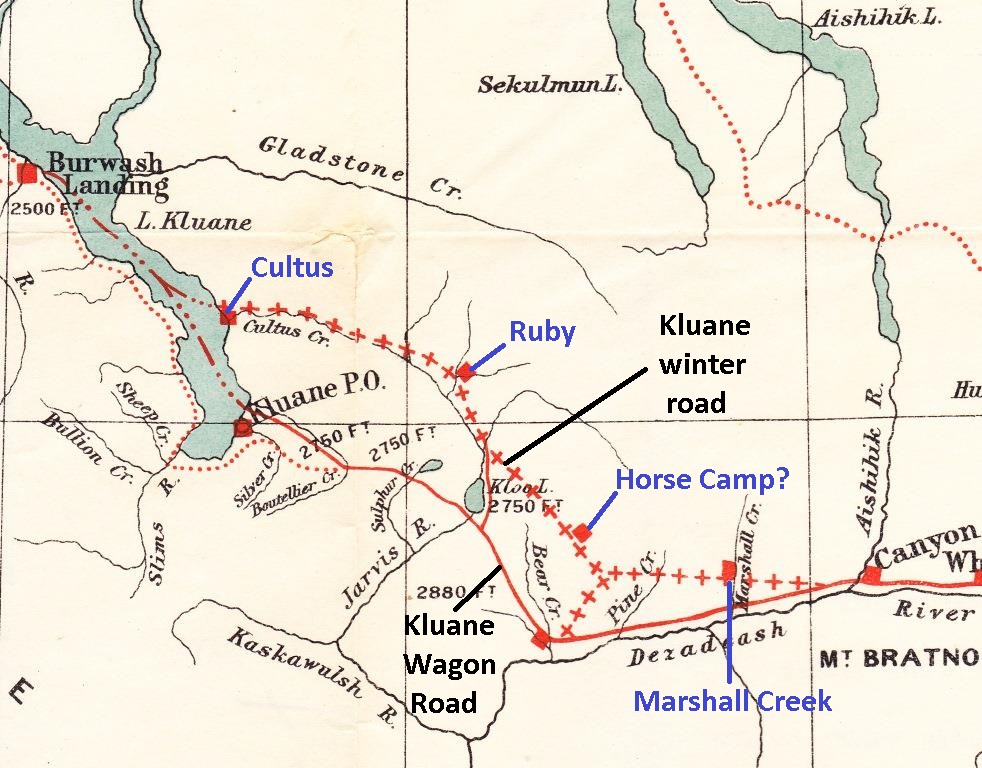
(Canada Department of Mines, Map 113A (Canadian Routes to White River District, Yukon, and to Chisana District, Alaska), 1914)
The reason for this winter road was increased mining-related activity to the northwest of Kluane Lake. By this time Burwash Creek near the northwest end of the lake was the most consistently productive gold-producing creek in the Kluane region. Seventy miles further to the northwest in the upper White River area, copper and gold prospecting was on the rise. In addition, the Yukon-Alaska boundary survey project in that area was going to require freighting access for the next several years.
The winter road was intended to support these activities by using frozen ground and the ice of Kluane Lake to provide a solid surface for freighting from Whitehorse into the western Kluane/White River region. It was also a more direct route, saving a number of miles, particularly the difficult ones over the Bear Creek and Boutellier summits. Chambers called it a “sleigh trail” because much of the country it traversed was only suited for freighting in the winter.
The Cairnes map shows the Marshall Creek roadhouse to be on Chambers’ Kluane winter road, but it was actually on the winter route of the Kluane Wagon Road. In the winter of 1908-09 when Chambers built the winter road to Kluane Lake, he would have branched off this winter route somewhere west of the Marshall Creek roadhouse and headed toward Kloo Lake and beyond to Kluane Lake.
A few years later in 1913, the gold rush into the Chisana area of Alaska near the Yukon border prompted the Whitehorse Board of Trade to produce an informational and promotional pamphlet to solicit the business of the goldrushers. It contained travel information, including that “Winter Time is Travel Time in the Northland”, and touting the “Kluane Trail” (meaning Kluane Wagon Road and the winter road) as the ideal route.
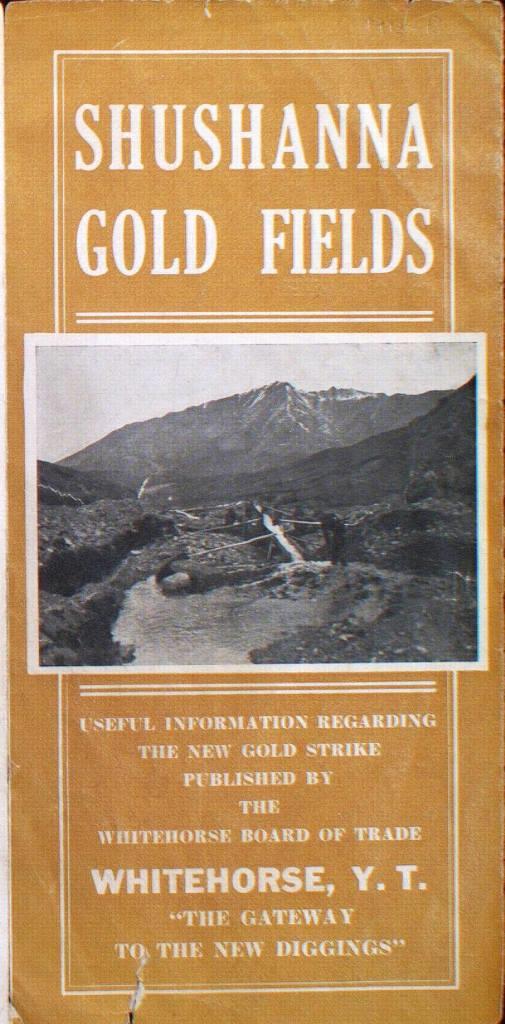
(Yukon Archives, PAM 1913-0013)
The Roadhouses
The Kluane area roadhouses were entrepreneurial endeavors, privately built and operated places, some of which began as tents. They were generally single-story log buildings (30 feet by 30 feet seemed to be an average size) and often had a stable associated with them. Some were run by couples while others appeared to have been operated by one or two men. Some roadhouses, particularly the ones that persisted for longer, also functioned as stores and fur trading posts .
The roadhouse scenario in the Kluane region was somewhat different than that for the roadhouses of the more well-known Dawson-Whitehorse Overland Trail. The latter were large, often two-story buildings operated by employees or contractors to the White Pass & Yukon Route for its mail, freight, and passenger services.
Below is a set of Google Earth images of the Kluane Wagon Road and the roadhouses along it and the connected routes. In all images, the Kluane Wagon Road is shown by the red line, the Alaska Highway is the white line, and the roadhouse locations are labelled in orange.
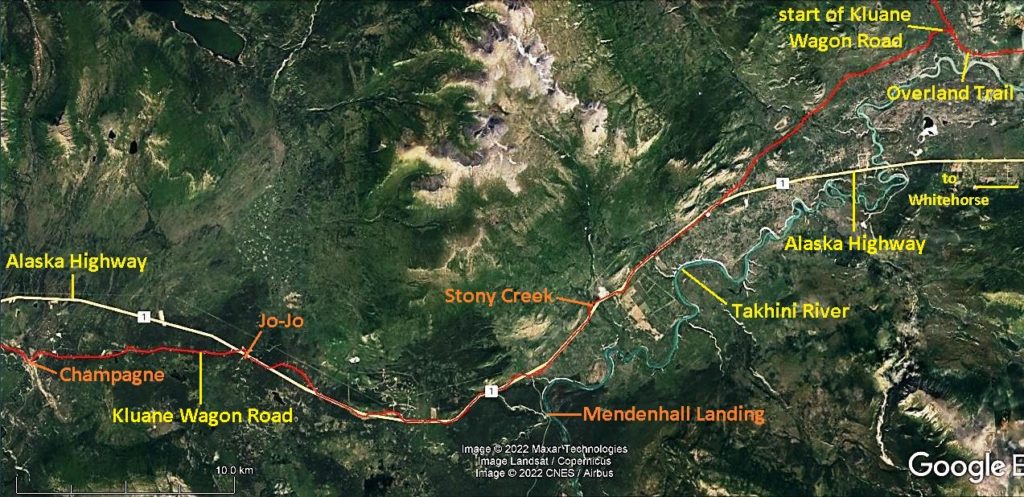
(Google Earth)
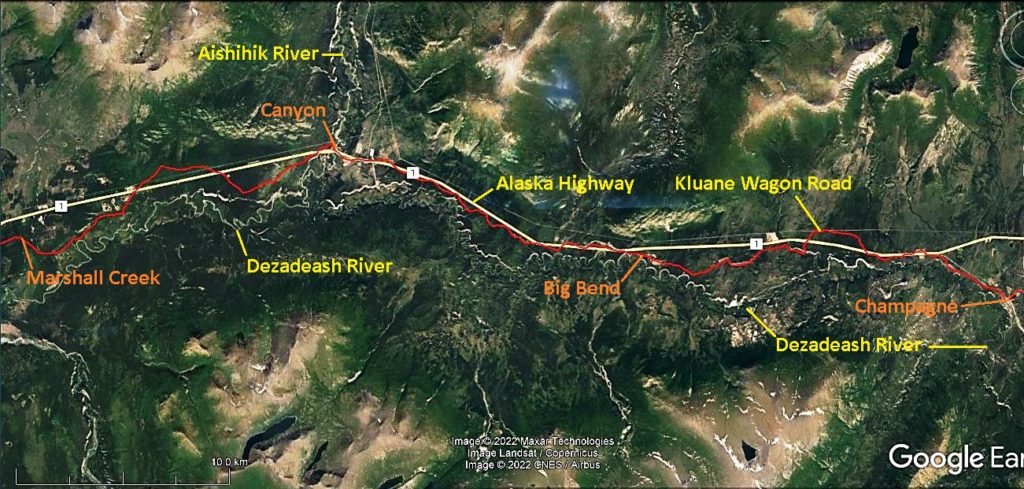
(Google Earth)
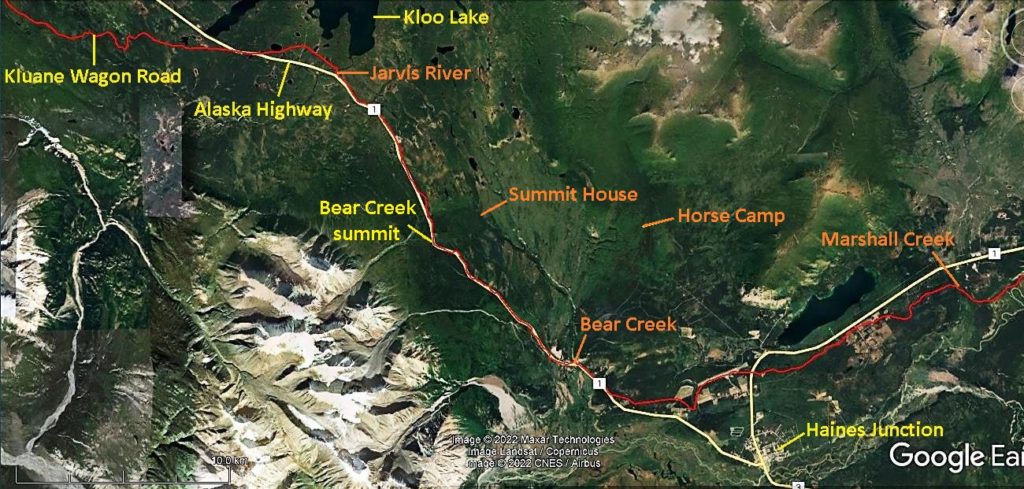
(Google Earth)
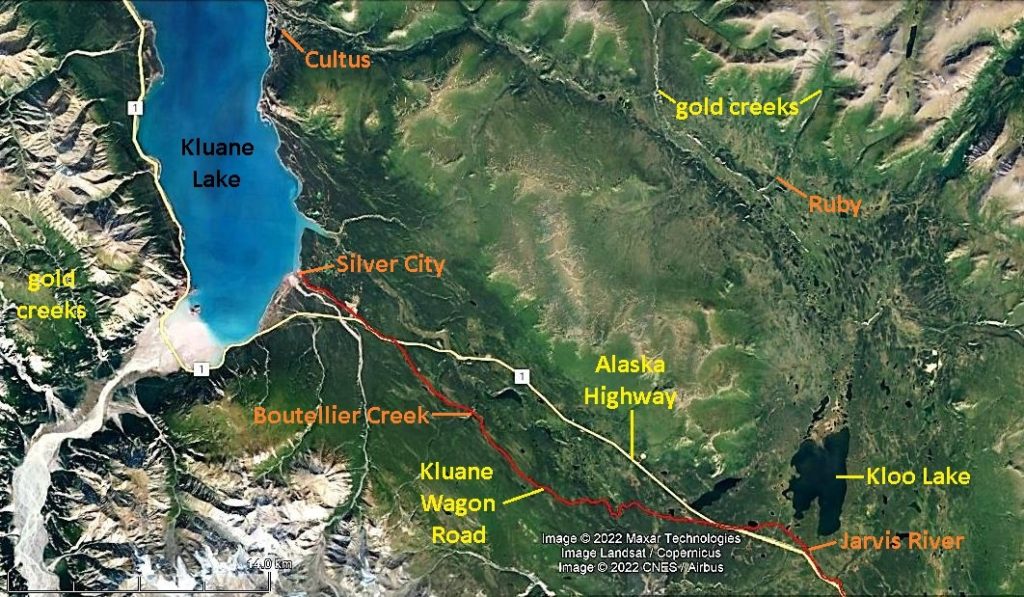
(Google Earth)
Roadhouse on Original Trail (pre-Kluane Wagon Road)
Prior to the Kluane Wagon Road being built, a number of roadhouses were established on the original trail that was used to access the region. This likely started to happen by the fall of 1903, and by March 1904 the following appeared in the Whitehorse newspaper: “the accommodation on the trail is first class, there being good, comfortable log roadhouses every 15 or 20 miles with log stables for horses and dogs”.
Summit House
A trail mileage chart from Whitehorse to Kluane Lake in April 1904 (six months before the Kluane Wagon Road was built) includes a place eight miles beyond Bear Creek called ‘Summit House’. This chart is the only place I have seen this name, and that may be because it didn’t last long when it was bypassed by the Kluane Wagon Road later in 1904.
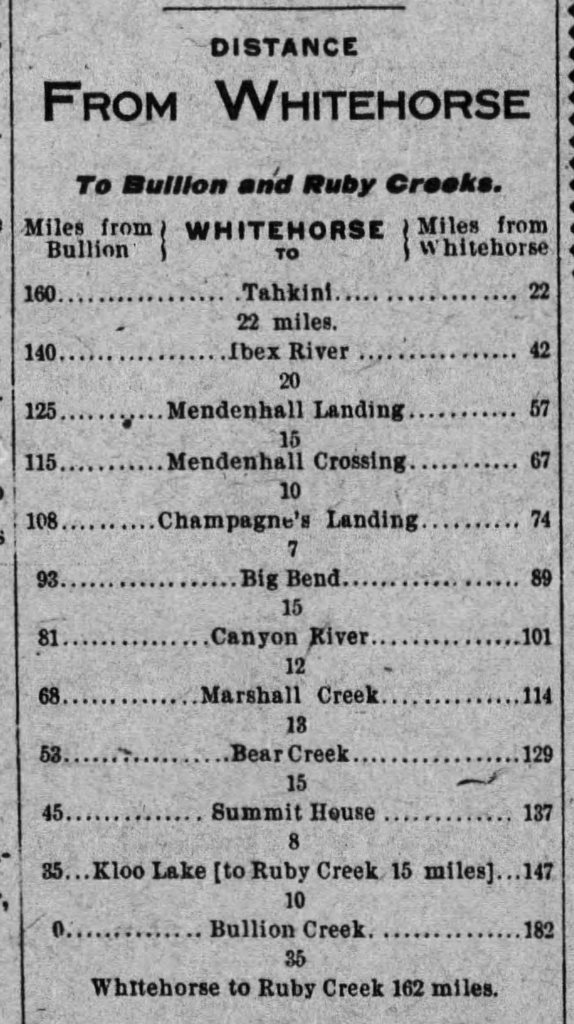
(however measured) changed significantly when the Kluane
Wagon road was put in.
(The Whitehorse Daily Evening Star, 13 April 1904)
About six air miles north of the Bear Creek roadhouse along this section of original trail that was bypassed by the Kluane Wagon Road are the remains of two old cabins and a low cache. The trail mileages given in the chart reasonably fit the location of these building remnants, so I believe they mark the site of Summit House.
The faint and often absent signs of a trail through fairly dense bush lead to the site of these old building remnants, which is not in a particularly attractive building area. The availability of firewood and water would have been primary considerations, but this location in a timbered valley likely also offered weather and travel conditions that were often preferable to the relatively heavy and drifting snows closer to timberline at the Bear Creek Summit.
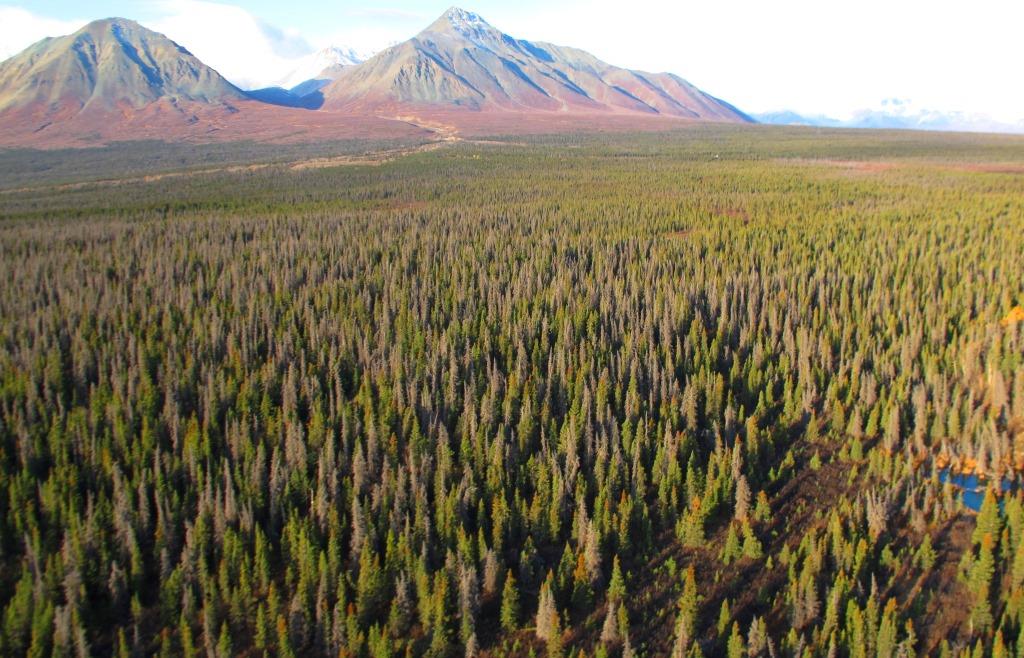
(Gord Allison photo)
The building remnants are very much deteriorated, likely due a combination of the relatively heavy snow loading and ground moisture at this site, as well as lack of use and maintenance from abandonment of the buildings early on.
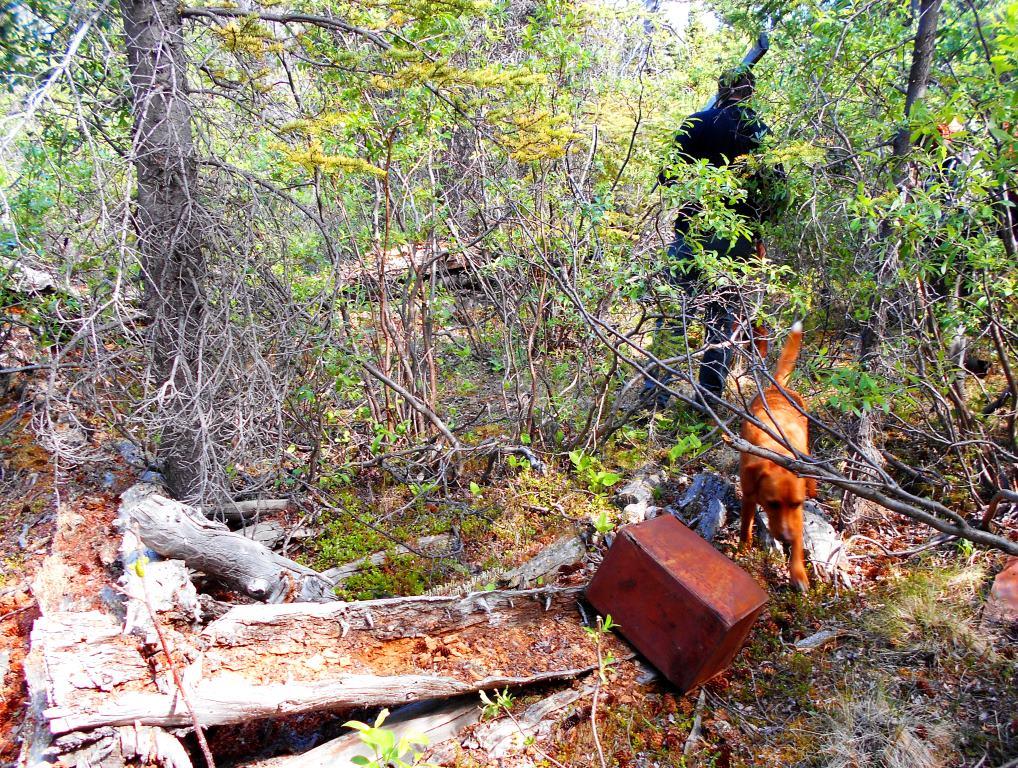
(Gord Allison photo)
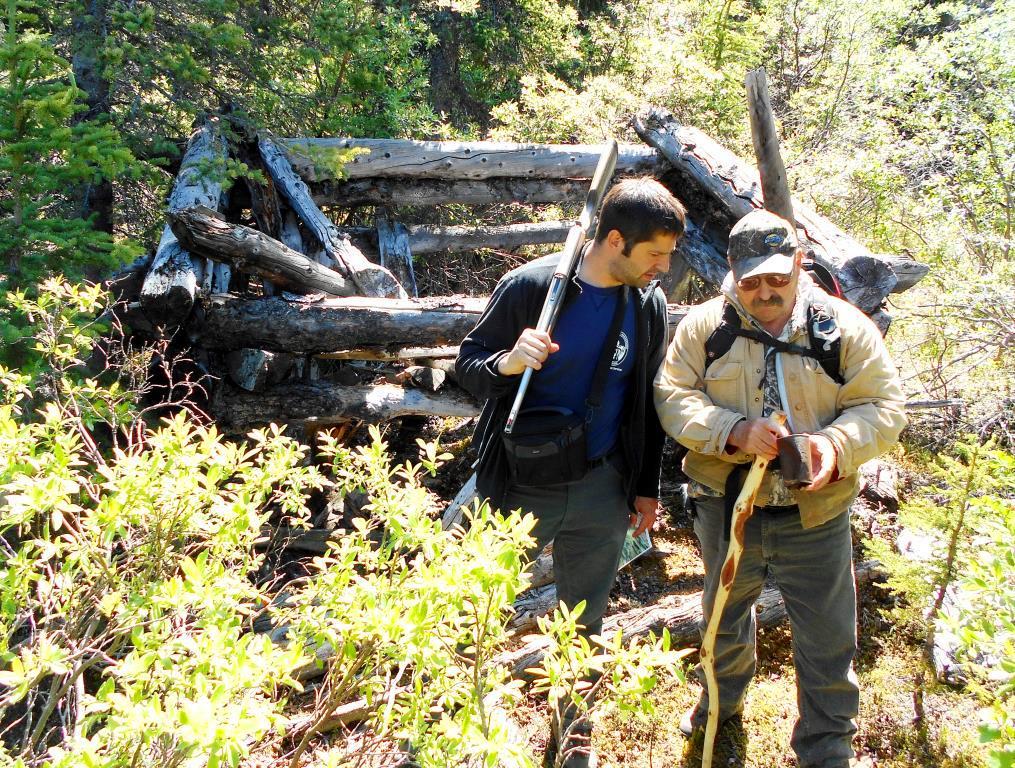
(Gord Allison photo)
Roadhouses of the Kluane Wagon Road to Silver City
A number of roadhouses were built along the original trail into the region, but unlike Summit House they became situated on the Kluane Wagon Road when it came through in the fall of 1904.
The first roadhouse going from Whitehorse was located at Stony Creek, about 14 miles from the previous roadhouse at 31-Mile of the Overland Trail. Stony Creek and the next three roadhouses were located within a 19-mile stretch (mile 45 to 64), meaning an average of about six miles apart. Beyond that to the west, the distance between the roadhouses to Silver City averaged about 12 miles.
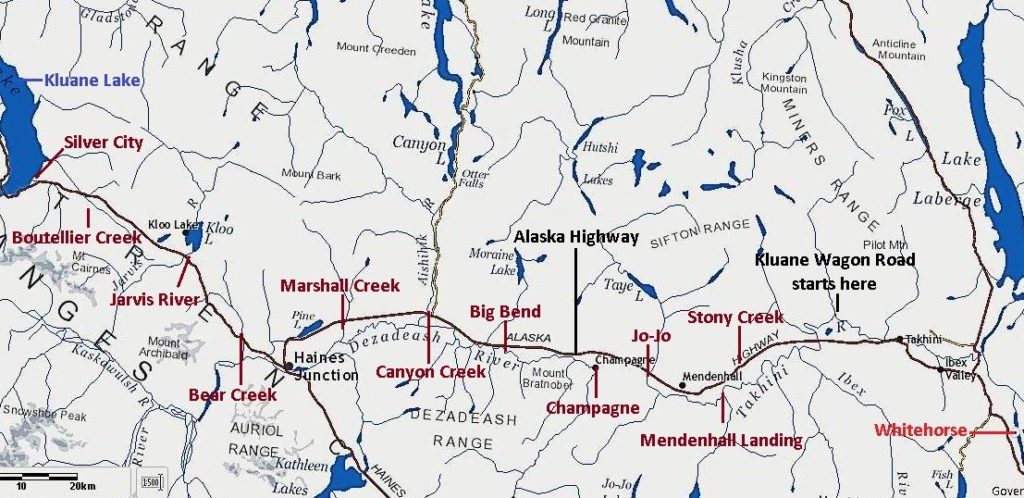
(GeoYukon Viewer)
Some land documents indicate that the Kluane Wagon Road had mileposts erected along it that showed the distance from Whitehorse, rather than from the actual start of the road. Therefore the first one after the road branched from mile 32 of the Overland Trail would have been mile 33. While I have found many survey posts along the road, I have never come across a milepost.
The following descriptions of the Kluane Wagon Road roadhouses proceeds from east to west, with their mileposts being the distance from Whitehorse.
Stony Creek (mile 45)
Stony Creek at mile 45 from Whitehorse is located near what is now kilometer 1485 of the Alaska Highway, on the north side. Thomas Hinchcliffe commenced construction of it in late 1904 and it seems to have been in somewhat sporadic operation by him and others until about 1914. The roadhouse and the buildings associated with it were still standing when the US Army established an Alaska Highway construction camp adjacent to it, but air photos indicate that the buildings disappeared within a few years after that.
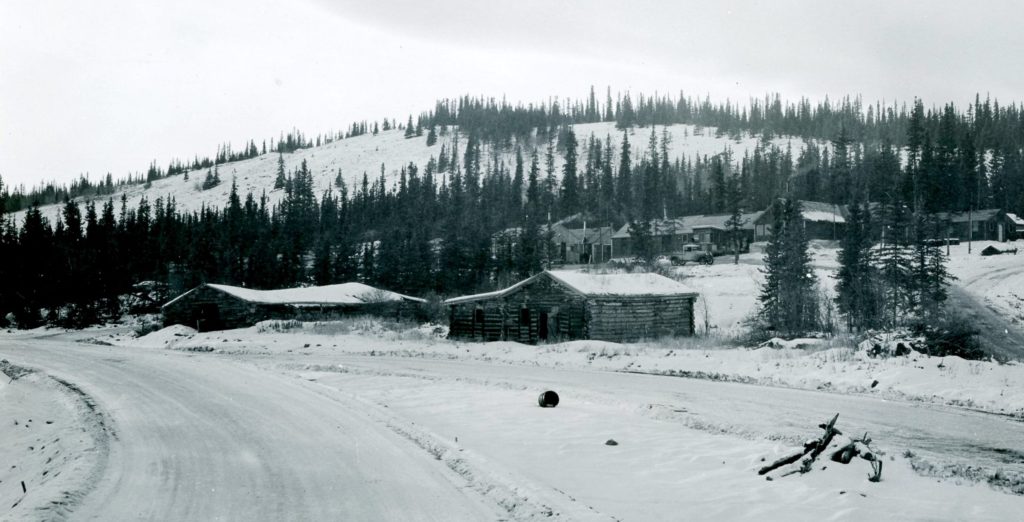
(National Archives & Records Administration, Alaska Highway project, #44-1252-A)
The Stony Creek roadhouse is one of the few Kluane Wagon Road roadhouses that has a fair amount of information about it. I posted an article about it in 2021, and a link to that article is at Stony Creek.
Mendenhall Landing (mile 48 + 1.25 miles south)
Mendenhall Landing (commonly called Steamboat Landing by local people) is at the junction of the Mendenhall and Takhini Rivers, and where the Kusawa Lake Road passes by. This is a little over a mile off of the Kluane Wagon Road at mile 48, now about kilometer 1489 of the Alaska Highway. Mendenhall Landing was an integral part of the early transportation system into the Kluane region because it could be serviced by small steamboats from Whitehorse via the Yukon and Takhini Rivers. This enabled people, goods, machinery and working animals to be transported by boat and avoid overland travel on the first third of the Kluane Wagon Road.
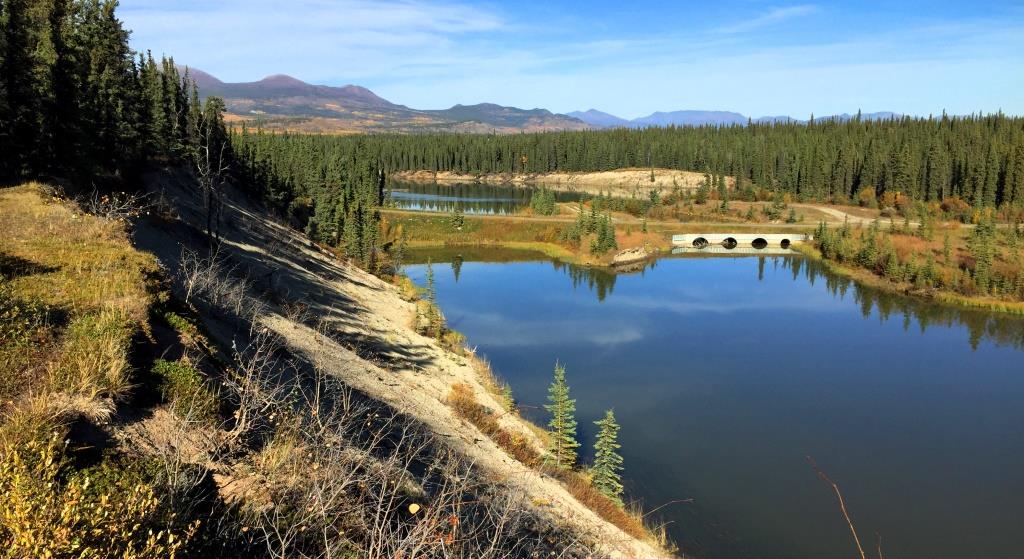
(Gord Allison photo)
In August 1903 Nathaniel Raymond, a steamboat captain, builder and owner, applied for 25.82 acres of land for agricultural purposes on the northern side of the confluence of the Takhini and Mendenhall Rivers. Here he constructed a relatively large roadhouse building of substantial logs and with a canvas top, which perhaps was meant to be temporary.
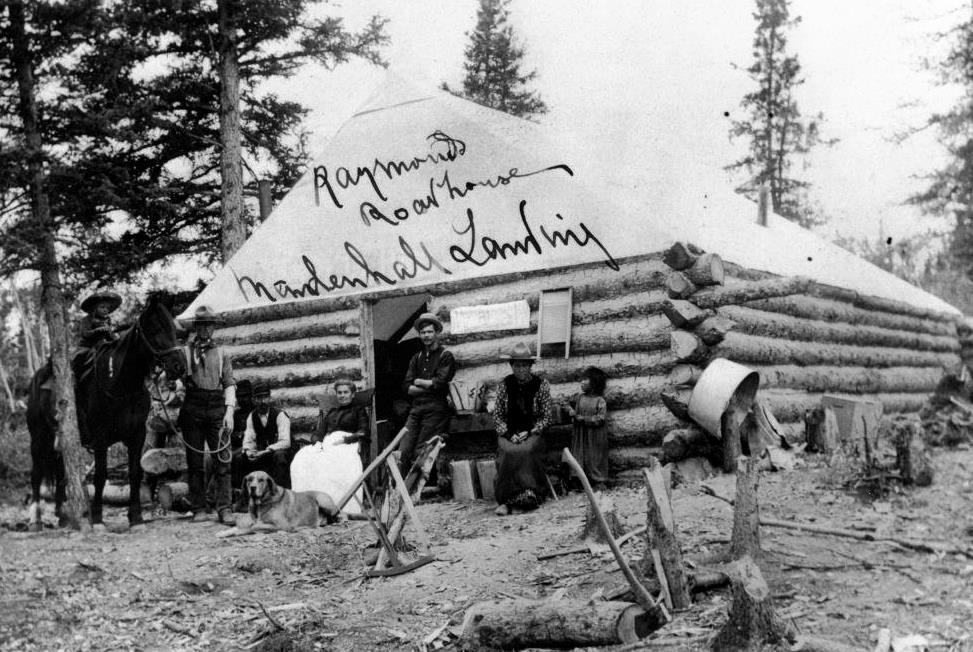
(Yukon Archives, William Shuckburgh fonds, Acc. 2002/126, #1 – photo has been cropped)
Raymond’s roadhouse was still operating a year later, in August 1904, evidently by his son-in-law William Mooreside, but it is not known for how much longer after that. There is no further information that the land he applied for was granted or what happened to the roadhouse.
Whitehorse newspaper articles in December 1903 and February 1904 refer to the now-famous Sam McGee and his partners as having a roadhouse at Mendenhall Landing and applying for a liquor licence there. However, there is no information confirming that they actually built and operated a roadhouse at this location.
An article in June 1904 said that Harry Chambers of Champagne had “interests” at Mendenhall Landing. It was not specified what these interests could be, but in July 1910 and again in April 1917 he was granted one acre of land in the same area where Raymond had applied several years earlier. The reasons for these land applications were likely for roadhouse or transportation purposes, but there is no record of him doing anything there.
In the area where both Raymond and Chambers had applied for land, and presumably where Raymond had built his roadhouse, there is no conclusive evidence remaining there. On a parcel of private land covering some of the area, there is a partial outline of logs under the ground surface that may have been a foundation for a roadhouse or associated building. A 1948 air photo shows a cleared area in the vicinity of the apparent roadhouse. There appears to be a building in one part of the clearing, but there is no longer one at that exact spot.
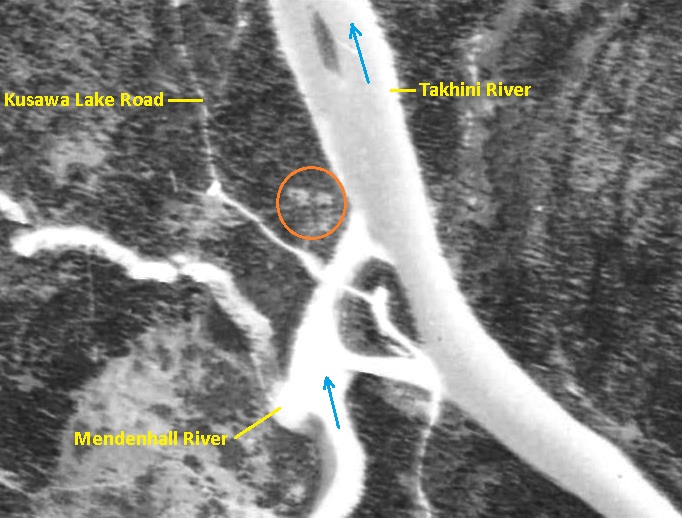
(National Air Photo Library, Line A11539, #103)
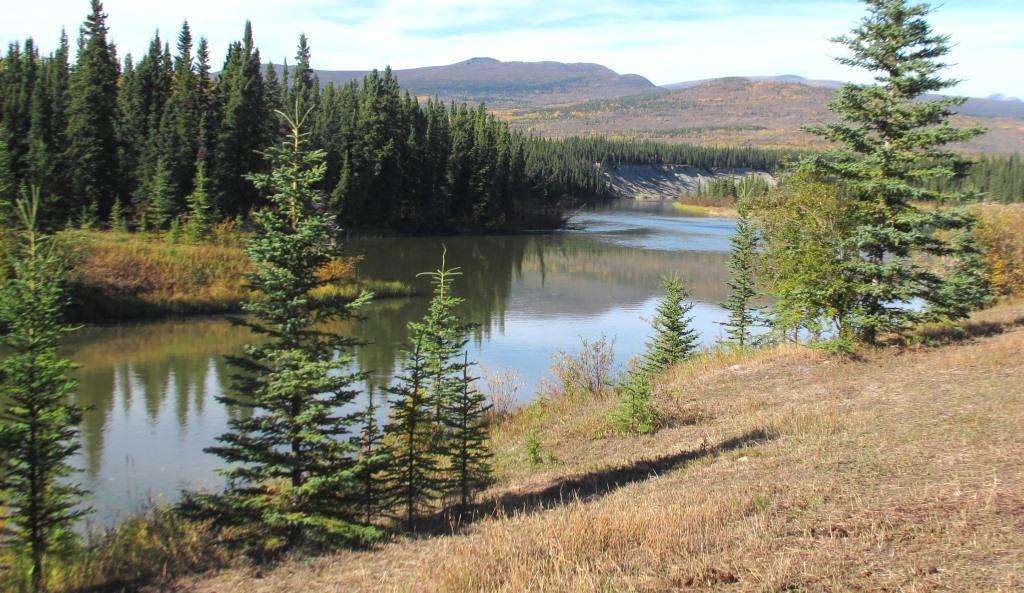
(Gord Allison photo)
Jo-Jo (mile 58)
About 13 miles to the west of Stony Creek and 11 miles from Mendenhall Landing is the site of the Jo-Jo roadhouse. This is near kilometer 1504 of the Alaska Highway, where the Kluane Wagon Road crossed the Mendenhall River that flows south from Taye Lake. The location was also referred to as Mendenhall Crossing, but the name ‘Jo-Jo’ may have been adopted to avoid confusion with Mendenhall Landing. This must be derived from Jo-Jo Lake, located 11 miles to the south, for which the origin of the name is unknown. A small First Nation settlement that was established near the roadhouse was also called Jo-Jo.
The builder of this roadhouse and when that occurred is not known. The earliest reference to it is in a June 1904 newspaper article, but no person’s name is associated with it.
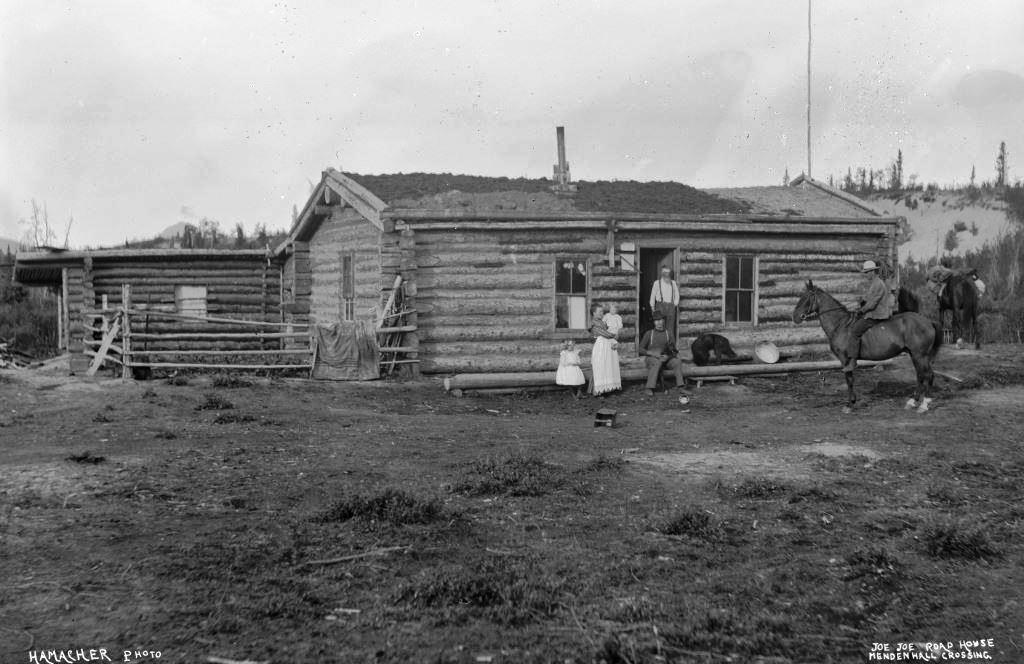
(Yukon Archives, E.J. Hamacher fonds (Hougen collection), Acc. 2002/118, #397 – photo has been cropped)
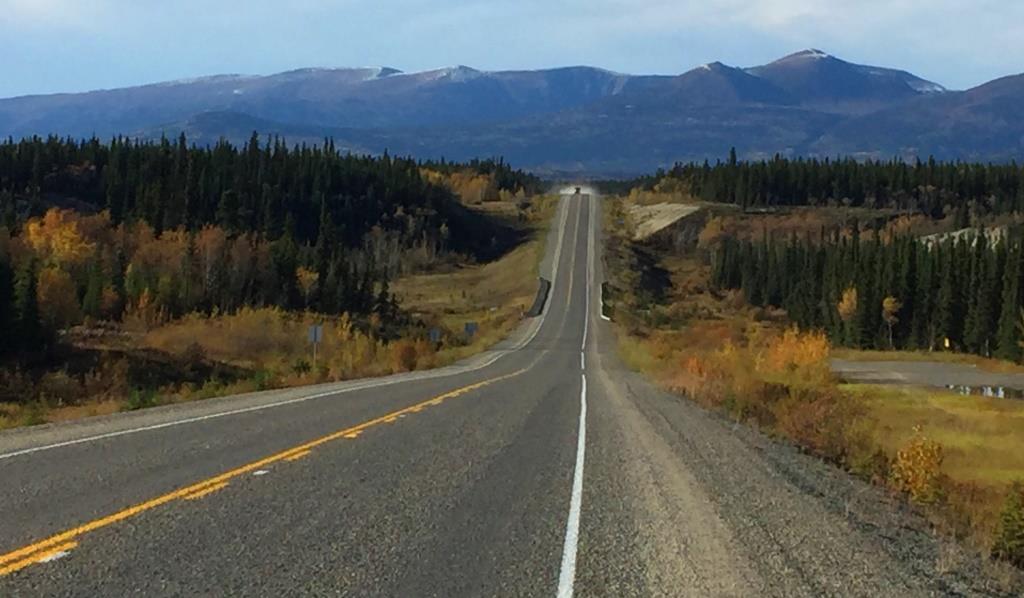
(Gord Allison photo)
In November 1905 a Peter Hansen (sometimes shown as Hanson) took charge of the roadhouse and also operated it as a store, bringing with him a stock of merchandise to sell. In early December 1905 he began advertising this in the Whitehorse newspaper regularly for the next two months.
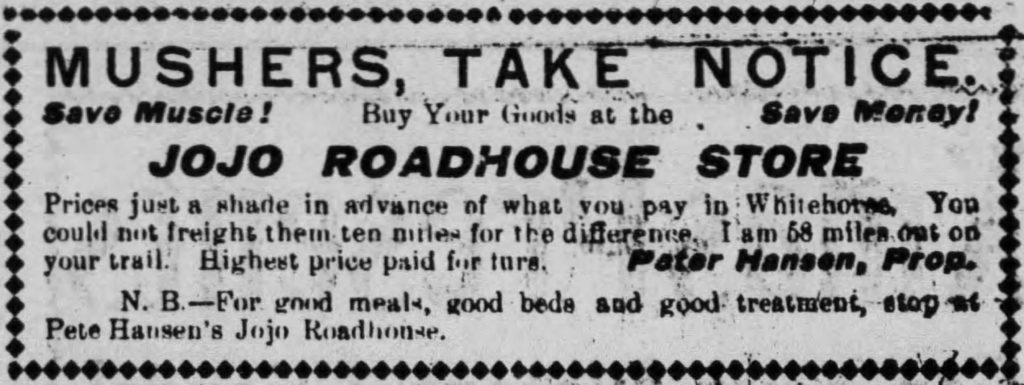
(The Whitehorse Daily Evening Star, 13 December 1905)
The last reference to Peter Hansen at the Jo-Jo roadhouse was in mid-December 1906, when one of his horses died on a trip to Whitehorse. It was stated that Hansen was also operating a trading post.
The next piece of information about the Jo-Jo roadhouse site is from 1909, when Harry Chambers of Champagne applied for land at the site. There is no information about the result of his application, but a 9.63-acre parcel of land encompassing the roadhouse site was surveyed for him in April of that year. The survey shows where the roadhouse and stable were located in the area close to the river crossing (the original river course was later altered to accommodate the installation of culverts).
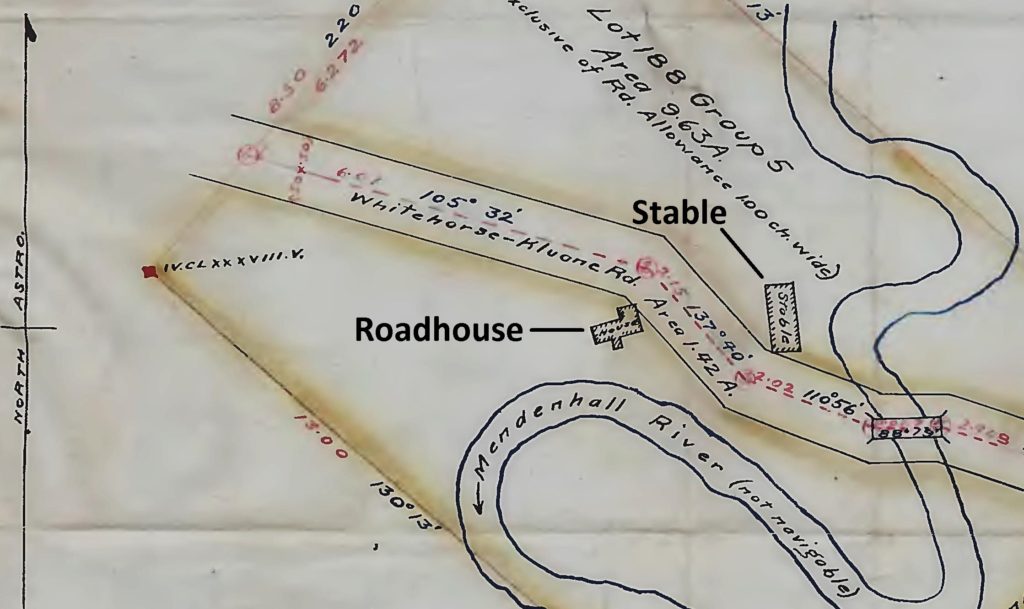
(Canada Lands Survey Records, FB 10720)
In May 1912 John McCoy, who sometimes operated the Stony Creek roadhouse 13 miles to the east, signed a homestead application for land near Champagne while at the Jo-Jo roadhouse. Whether this roadhouse was being operated by him at this time or someone else is not known.
Chambers had to apply again in April 1913 to purchase this land, and undoubtedly did so because it was the beginning of the Chisana gold rush and the Jo-Jo location would present a business opportunity for him. There is no information about this actually taking place, nor what happened to the roadhouse buildings. In 1942 this area became the site of an Alaska Highway construction camp, and if the old buildings were still there they may have been destroyed at this time.
Champagne (mile 64)
Six miles west of Jo-Jo is the village of Champagne (or Champagne Landing) on the east bank of the Dezadeash River at the point where it flows from the south and turns to head west. Champagne was on the original Alaska Highway, but a major highway revision in 2000 means that the village is now accessed by side roads at kilometers 1504 and 1518.
Champagne is located at the crossroads of two major routes, both in pre-contact and historical times. A First Nations trading trail that ran north-south through the Champagne area had been taken over by the entrepreneur Jack Dalton in the mid-1890s to deliver goods and livestock to the Klondike goldfields. Harry Chambers, who had worked for Dalton, and his wife Annie Kershaw established themselves in 1902 at what was to become Champagne, a fortuitous or perhaps visionary decision. When gold was discovered the following year to the west in the Kluane region, the Chambers’ were well situated to serve travellers when the east-west Kluane Wagon Road soon came past their door.
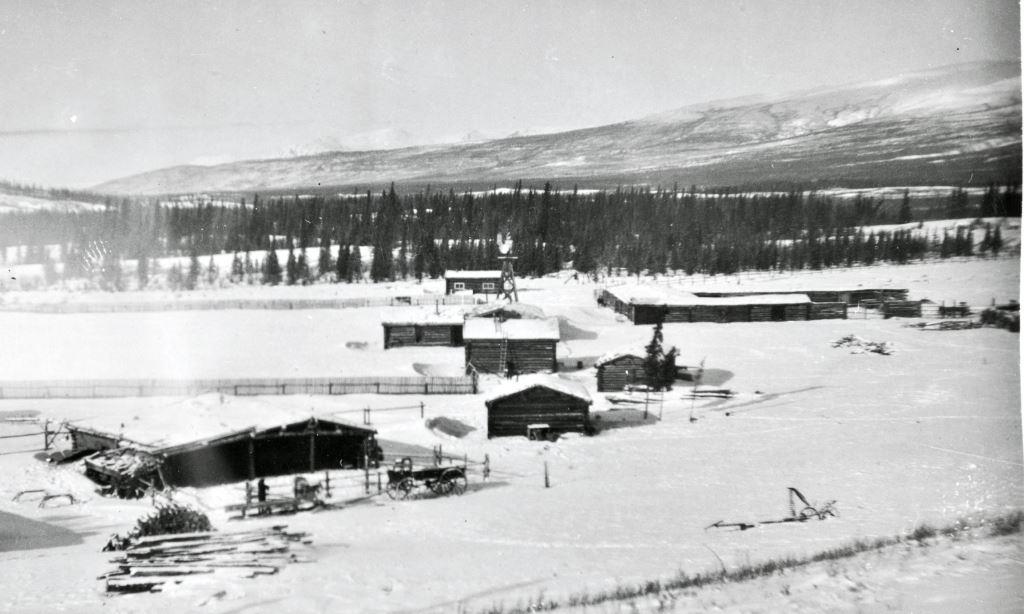
(Yukon Archives, E.J. Hamacher collection, Acc. 85/75, #62 – photo has been cropped)
After the Kluane gold rush subsided and most roadhouses on the Kluane Wagon Road closed, the Chambers’ remained at Champagne and began to raise a family there. A small community also began to grow around them, with eventual establishment of a North-West Mounted Police post, two churches, and another store.
A few newspaper articles and other accounts, including big game hunting books, indicate that the Chambers’ continued to operate their roadhouse and store for many years. While business would have been much more sporadic, there were some spikes in activity they may have been able to count on.
For at least four years from 1908 to 1913, the Chambers’ wintered horses for the Yukon-Alaska boundary survey parties that used the Kluane Wagon Road to access the border region. Their establishment undoubtedly incurred some business in the spring of those years when the survey crews arrived to prepare and collect the horses, and then again in the fall when they were brought back for the winter.
By 1911 big game hunting began to grow as an industry in the southwest Yukon, and although seasonal it likely provided the Chambers’ with some predictable business. Harry Auer, in writing about his 1914 hunting trip, said that Chambers had “built a large cabin for himself with many bunks for prospective travellers”. Auer also observed that “his place looks like a very up-to-date ranch, with its windmill to pump water into the cabin; it is immaculately clean and his [First Nation] wife is an excellent cook”.
In 1913 and 1914 the Chisana gold rush brought many prospective gold miners along the Kluane Wagon Road through Champagne, and the Chambers’ would have benefitted from this as well. Newspaper articles indicate that they ran the roadhouse for some years following, but the details are scant. Photos from 1919 and 1920 refer to the building as both a roadhouse and a trading post, so it may have served a dual purpose or was in a time of transition.
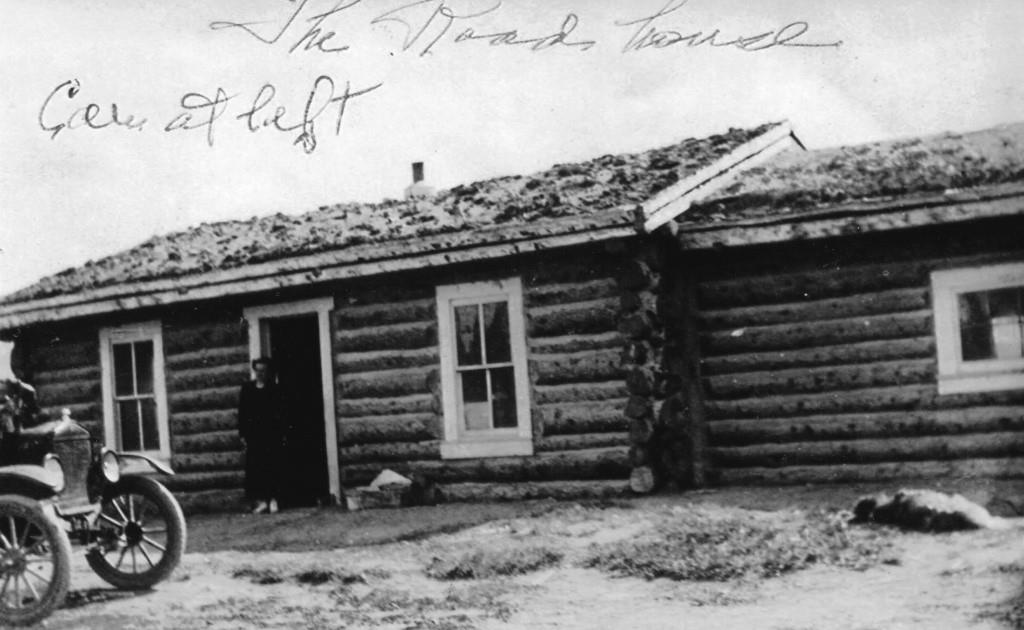
(Watson family collection)
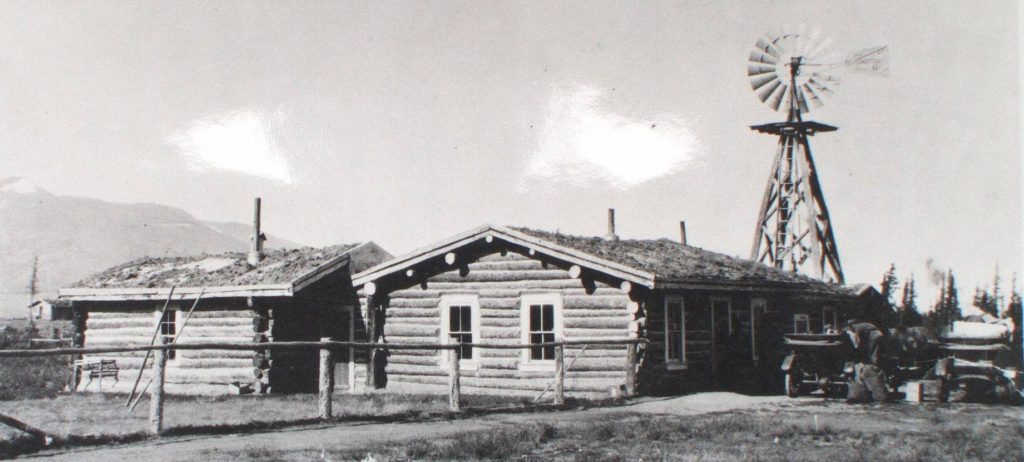
(Yukon Archives, Harbottle Family fonds, Acc. 82/345, #6096 – photo has been cropped)
Harry Chambers died in Whitehorse in 1929 and his wife Annie, after remarrying, died in 1946. They have many descendants in the Yukon, and there may be more information and stories about the roadhouse in the family lore.
In March 1962, the roadhouse building, by then deemed historic, burned to the ground along with most of its contents. A newspaper article about the loss said that work had been underway remodelling the building to be reopened as a stopping place on the Alaska Highway.
Big Bend (mile 77)
From Champagne the Kluane Wagon Road followed west along the Dezadeash River valley for more than 40 miles, but there is only one point where it was right beside the river. This is about 13 miles west of Champagne at an area known as Big Bend, a name with little meaning because it is just one of a great many bends in the river. It is an aesthetically pleasing location in what was a large meadowed area at the time of the roadhouse. The site is located about a quarter of a kilometer south of Alaska Highway kilometer 1532.
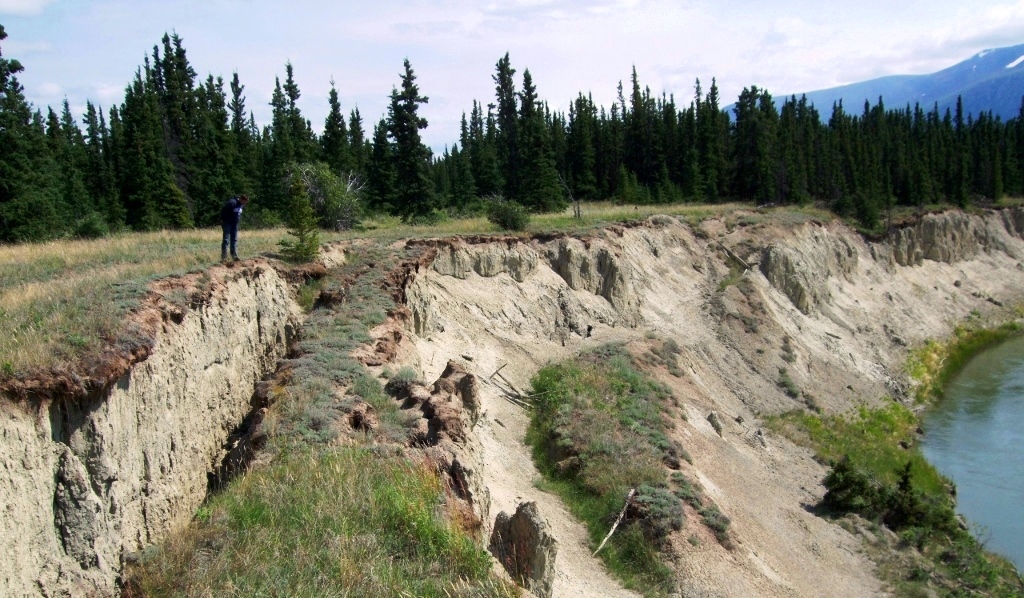
(Gord Allison photo)
The first reference to a roadhouse at Big Bend was in February 1904, when John French of Whitehorse was issued a hotel liquor licence. A month later he and Arthur Goodell applied for five acres of land at this location, and by early May there was a roadhouse built there, according to a newspaper article.
In June 1904, the Whitehorse newspaper advertised a ‘Dezadeash roadhouse’ for rent, located 22 miles from Steamboat (Mendenhall) Landing, which would be west of Champagne. This could be French and Goodell’s roadhouse before their location was called ‘Big Bend’, although the 22-mile figure given doesn’t fit well with the actual distance, which is closer to 30 miles.
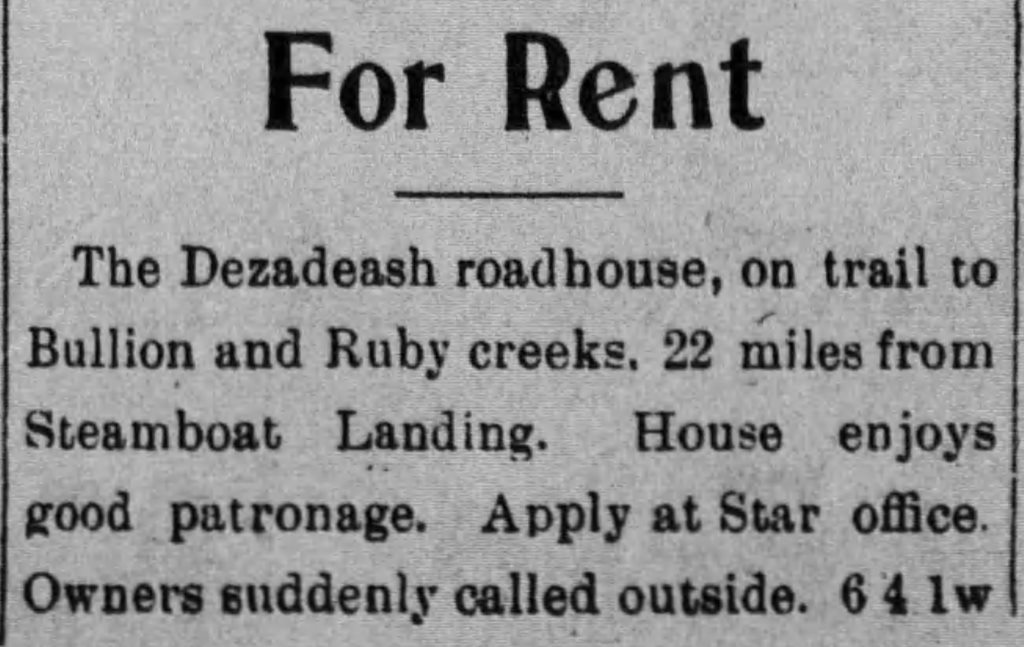
(The Whitehorse Daily Evening Star, 7 June 1904)
A newspaper article suggests that French and Goodell ran the roadhouse over the winter and closed it up for the summer season in early April 1905. That may have been their last involvement at the location, and their land application was cancelled in early 1908. Their roadhouse stood, probably used occasionally by travellers, until it burned down in about 1912.
In June 1913 Harry Chambers of Champagne applied for one acre of land at the site for a roadhouse, likely in response to increased traffic associated with the Chisana gold rush. However, it appears he didn’t do anything there and his application was closed in July 1919.
The only remains at the Big Bend location now are the remnants of a fence and a few logs embedded in the sluffing clay bank of the Dezadeash River.
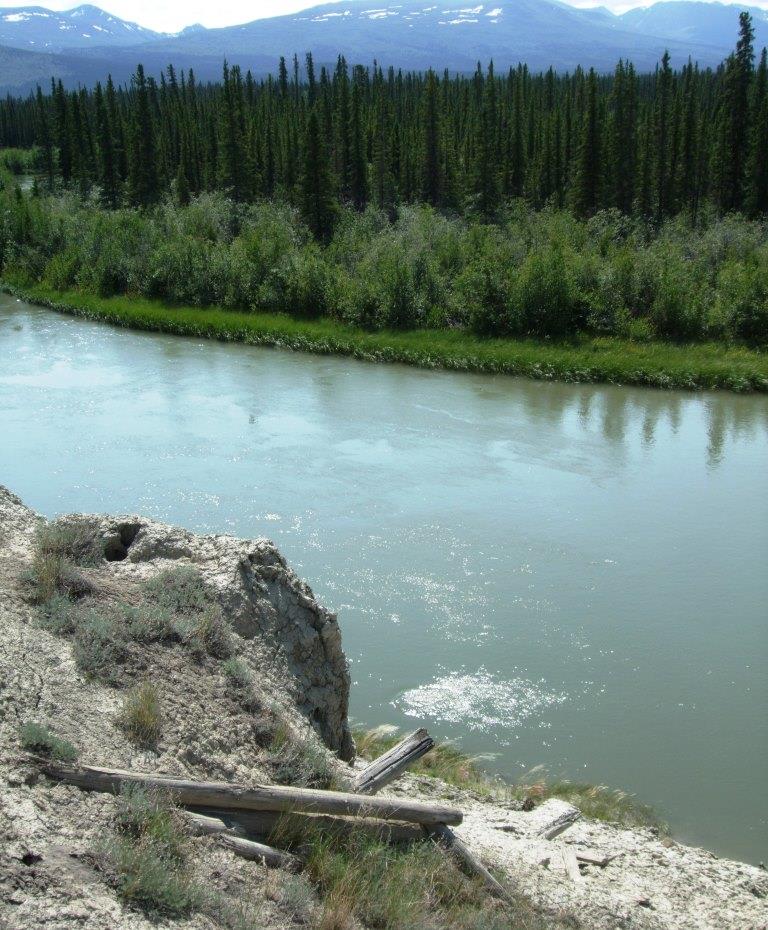
Logs embedded in the sluffed bank are remnants of the roadhouse operation.
(Gord Allison photo)
Canyon Creek (mile 88)
About 11 miles west of Big Bend, the Kluane Wagon road crossed the Aishihik River at the foot of a hill that frequently posed difficulties for travellers. This location, known as Canyon Creek, is near kilometer 1548 of the Alaska Highway and is now the site of a community of the same name.
By December 1903, Sam McGee and his partners Gilbert Skelly and Edwin Gideon were putting up a roadhouse there, and in February 1904 were issued a liquor licence for it. That spring they spanned the river with a 112-foot log bridge that has been rebuilt a few times and is now a historic point of interest.
The location of McGee and partners’ roadhouse at Canyon Creek roadhouse is uncertain. There is only one old log building remaining in the vicinity, a large one on the west side of the river. It has only one small window in the back side and a dirt floor, making it appear more likely to be a stable than a roadhouse. It is unfortunate that knowledge of this large old building, the roof of which has only collapsed in recent years, has slipped away.
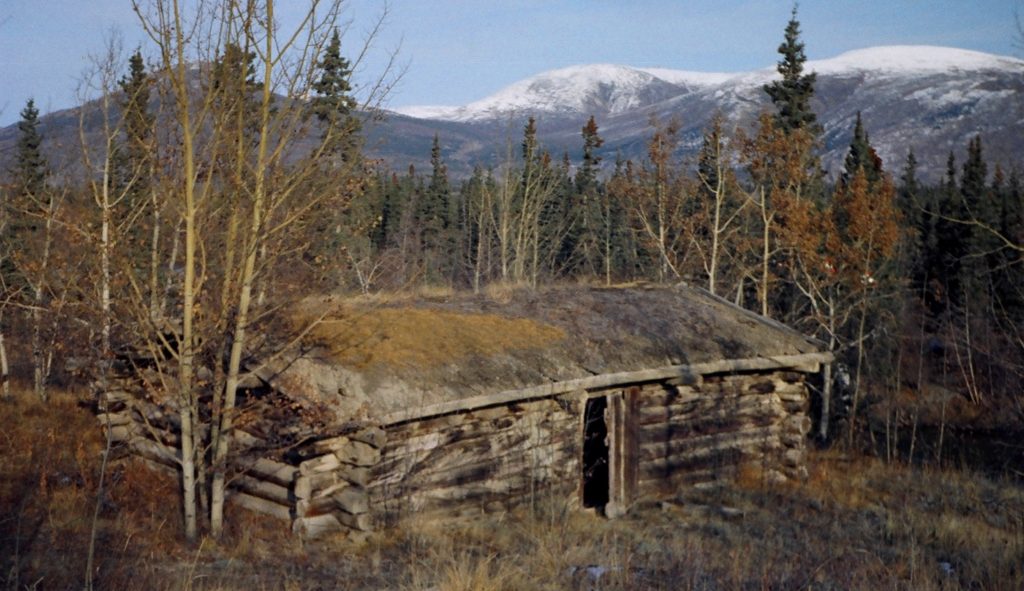
(Gord Allison photo)
An undated photo (likely 1904) by E.J. Hamacher, the Whitehorse photographer, shows the Canyon Creek bridge with a large canvas tent structure not far from it, and no other buildings. Since McGee et al evidently had their roadhouse in place before they began constructing the bridge, there is a good chance this tent is the roadhouse, probably a temporary one.
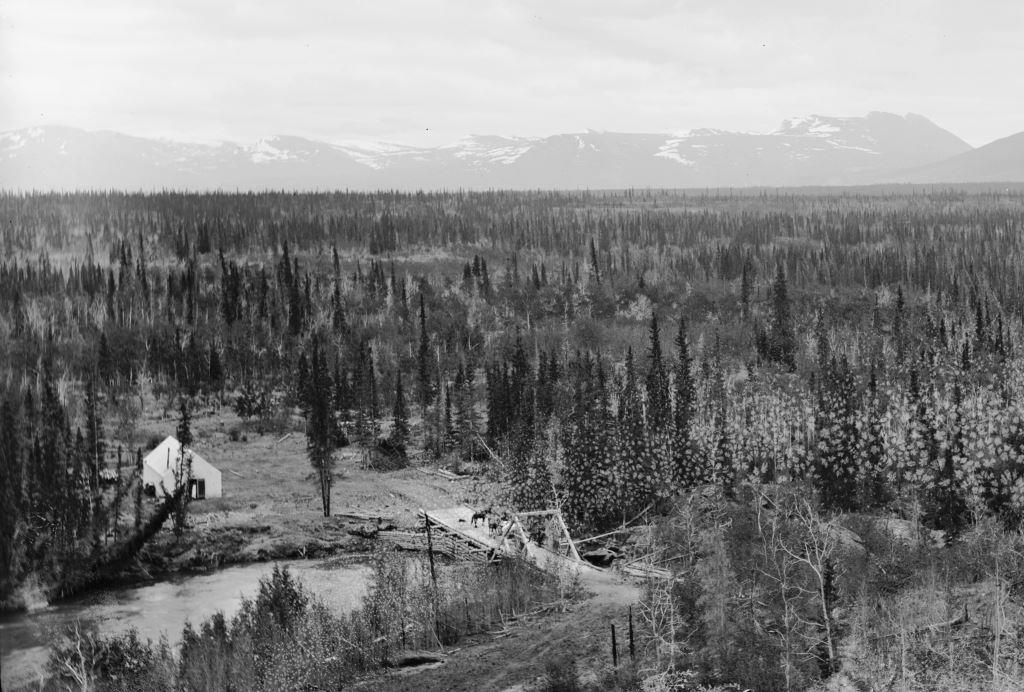
(Yukon Archives, E.J. Hamacher fonds (Hougen collection), Acc. 2002/118, #864 – photo has been cropped)
McGee, Skelly and Gideon moved on to other ventures and I have found no information about anyone taking over the roadhouse. Later photos of the site show a log building in about the same location as the tent had been. This may have been built as a more permanent roadhouse by McGee and partners while still at Canyon or by somebody who came later.
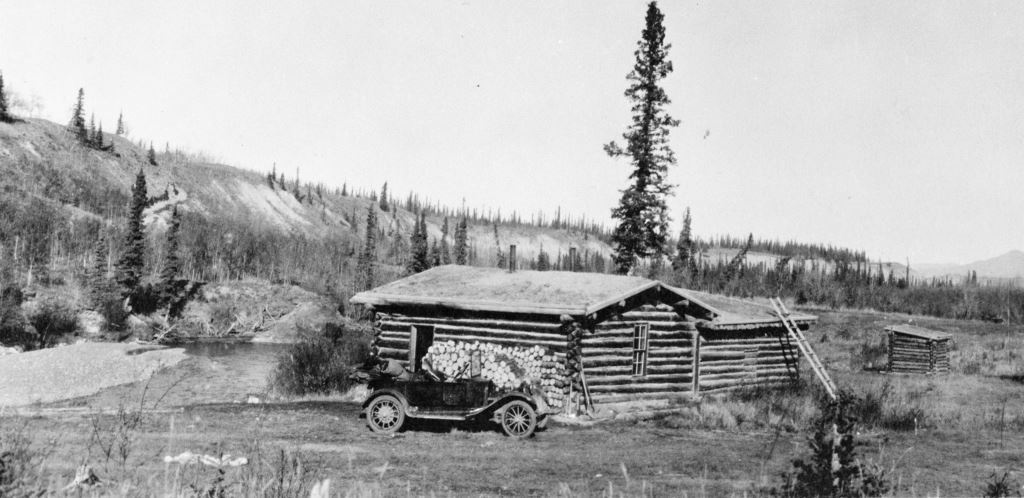
(Yukon Archives, Harbottle Family fonds, Acc. 82/345, #6087 – photo has been cropped)
The only other information about anyone operating a roadhouse at Canyon is from October 1923, when it was noted that Joseph Selby was doing so, but there are no details about this. Selby was in the Kluane area for many years working at various endeavors.
It is not known what happened to the building that may have been the roadhouse, situated just off the road on the east side of the bridge. It is still present in US Army 1942 photos during the construction of the Alaska Highway, but appears to be gone in a 1948 air photo.
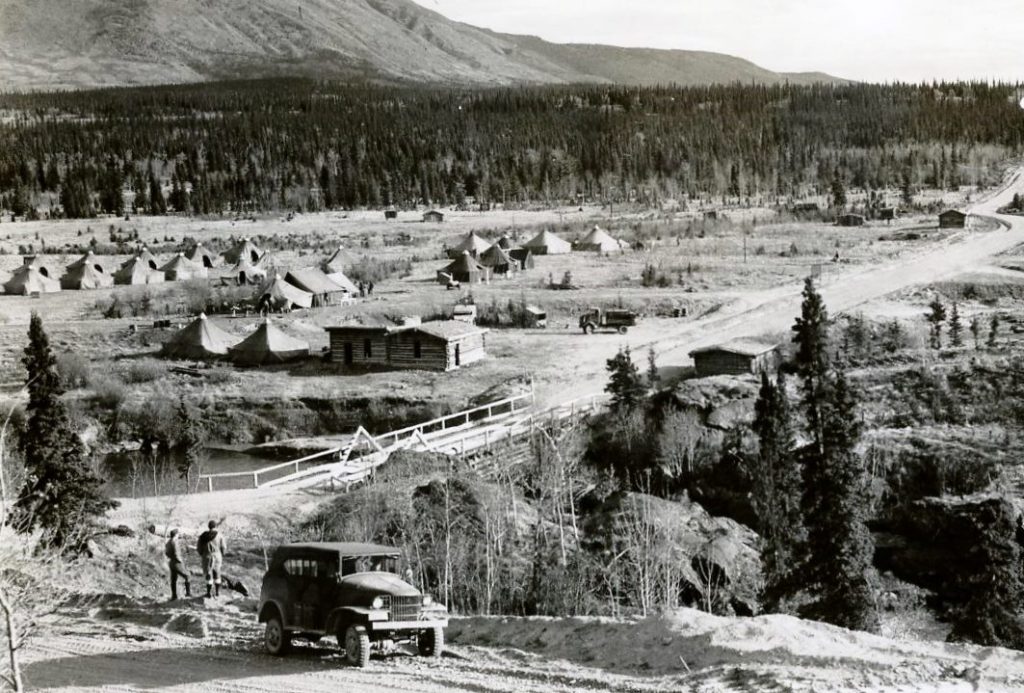
(National Archives & Records Administration, #42-5033)
Marshall Creek (mile 100)
Twelve miles west of Canyon Creek along the Kluane Wagon Road is the site of the Marshall Creek roadhouse. It is about 10 miles east of Haines Junction, less than a mile south of kilometer 1563 of the Alaska Highway. This roadhouse was on the winter route of the wagon road in this area.
Little is known about this roadhouse. The first reference to it is from March 1904, when a George Allen was said to be running a store there. The next pieces of information are from March 1915 and August 1916, when a George Duke was identified as a “Marshall Creek roadhouse man”.
Fortunately the Marshall Creek roadhouse was documented by the prolific and foresighted photographer Cst. Claude Tidd of the Royal Canadian Mounted Police on an April 1922 trip through the area. His photo shows a two-room building with fenced areas on either side, one possibly for a garden and the other a field or pen for horses. A helpful part of the photo was the inclusion of a mountain in the background with a distinctive pattern on it, which my son Neal was able to match up to determine the general area of the roadhouse.
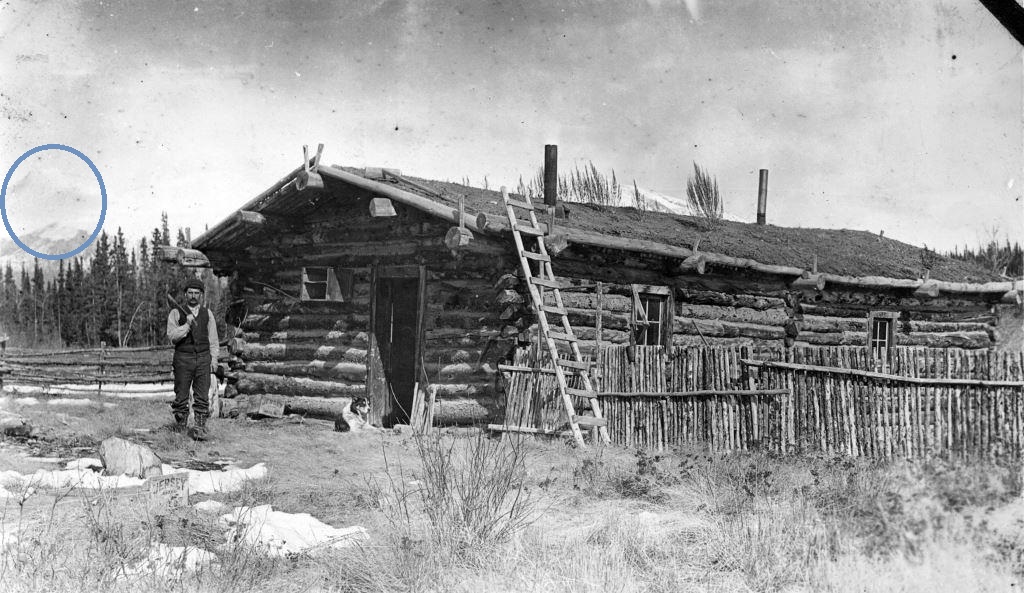
(Yukon Archives, Claude and Mary Tidd fonds, Acc. 77/19, #7221 – photo has been cropped.)
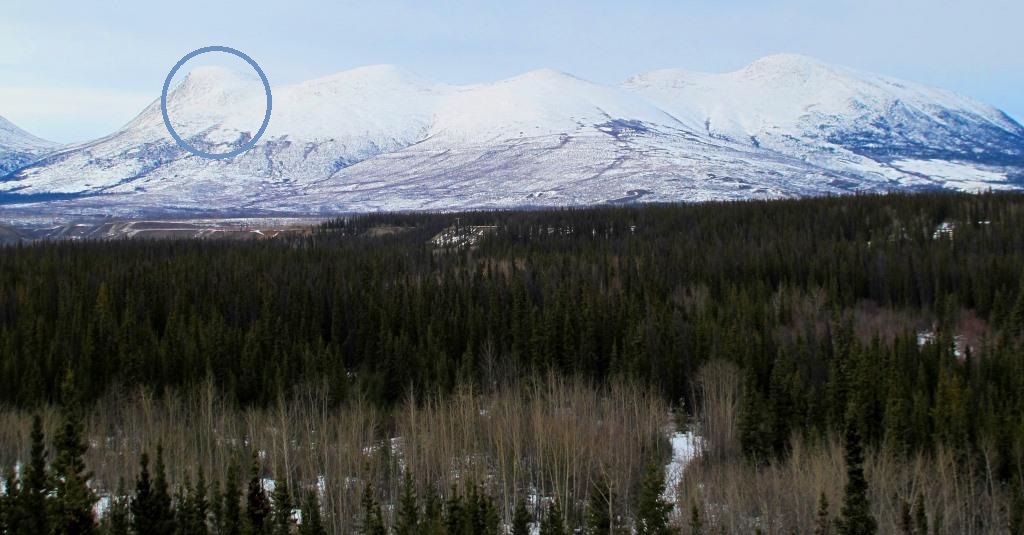
(Gord Allison photo)
Tidd’s information accompanying his photo refers to it as abandoned when he was there in 1922. The elder Marge Jackson, who played in the roadhouse as a child, was born in 1918, so it might be reasoned that the building was in place until at least 1930.
In the 1960s the area of the Marshall Creek roadhouse became occupied by logging and sawmilling operations. If the roadhouse had not already been removed or destroyed by this time, it may have happened as a result of these operations making way for their own buildings and activities.
Today the Kluane Wagon Road can still be traced through this area, but there is no obvious evidence on the ground of exactly where the roadhouse stood. However, I believe the Marshall Creek roadhouse shows up on a 1948 air photo. It is difficult to see on the enlarged reproduction of the air photo below, but a building-sized object that casts a shadow is visible beside the wagon road and not far from the creek. It also appears to be oriented in the same east-west direction that the Tidd photograph shows.
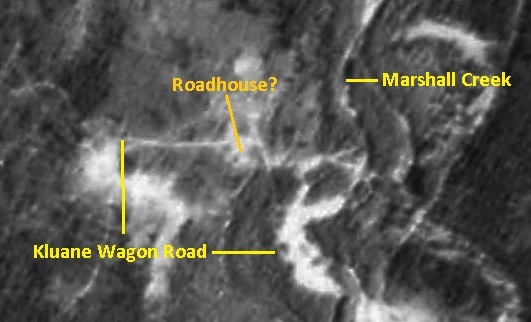
(GeoYukon Viewer, Line A11539, #67)
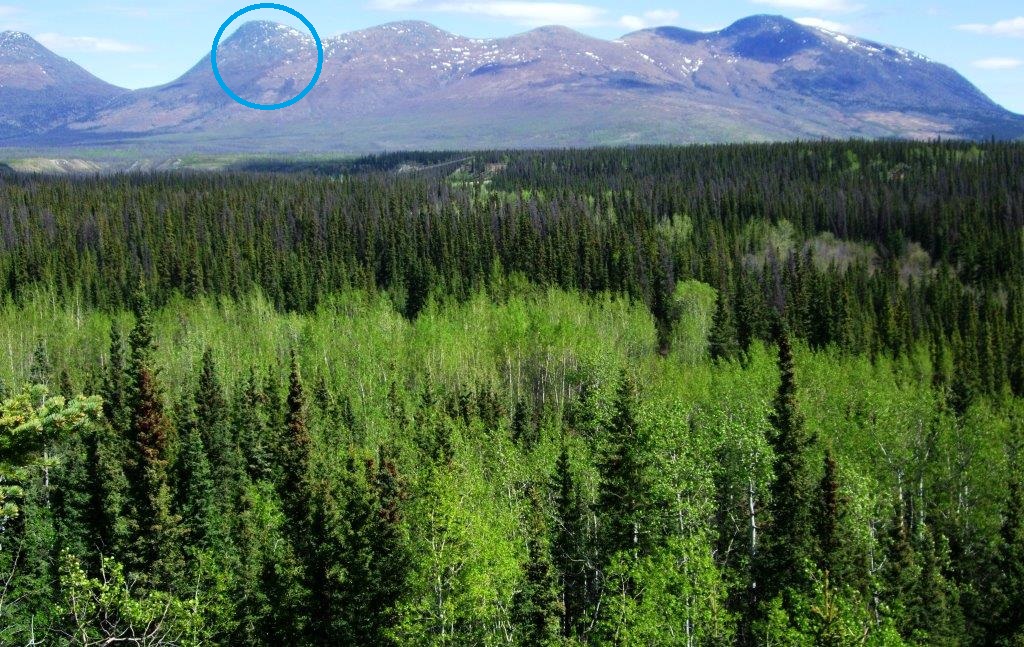
(Gord Allison photo)
Bear Creek (mile 114)
The Bear Creek roadhouse was 14 miles west of Marshall Creek, at about kilometer 1589 of the Alaska Highway where it crosses Bear Creek. In late 1903 Eli Proulx started building the roadhouse and he took on a partner named Joseph Beauchamp, who ended up owning and operating it for the next 25 or so years. After that it was operated by George and Dorothy Mackintosh, with Dorothy running it for several years after George died.
Like Champagne, this roadhouse remained in operation much longer than the others on the Kluane Wagon Road. It continued to provide service to travellers on the Alaska Highway for many years, and is still a site of private enterprise, now of a different purpose. There are no longer any original buildings at the site.
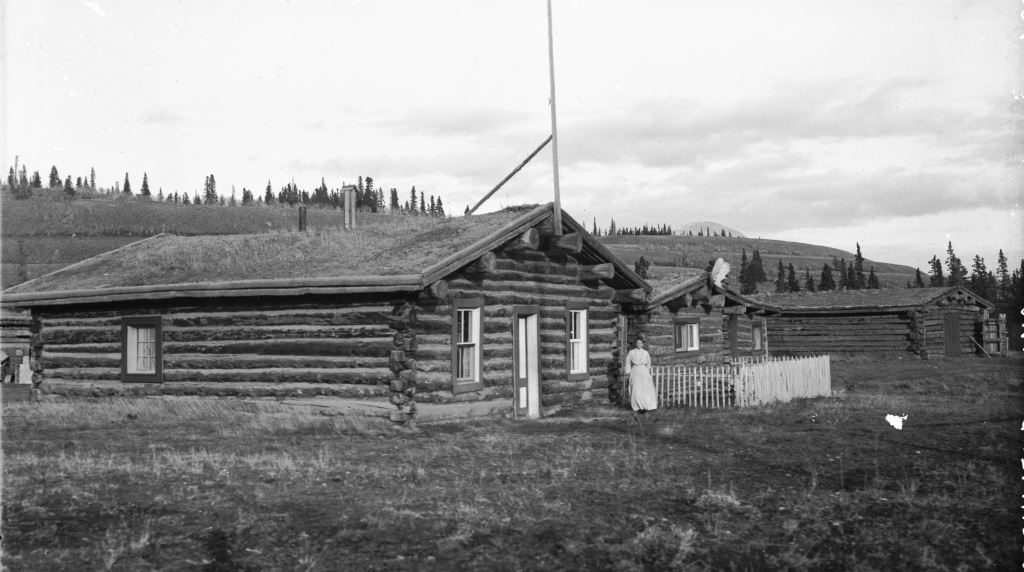
(Natural Resources Canada #44078)
The Bear Creek roadhouse has the most information about it of all the Kluane Wagon Road roadhouses, and this can be seen in two previous articles about it and its successor, the Mackintosh Trading Post. The links to them are: Bear Creek Roadhouse and The Mackintosh Trading Post.
Jarvis River (mile 126)
Twelve miles beyond Bear Creek to the northwest, up and over the Bear Creek summit, is the location of the Jarvis River roadhouse, a short distance north of the Alaska Highway near kilometer 1608. It is shown on the geologist McConnell’s 1904 map, so was in existence by that time, but I have found little information about it. The only early reference I have come across is one short sentence in a newspaper article from November 1905: “Percy Blakie a roadhouse man at Jarvis River, is in [Whitehorse] on business”.
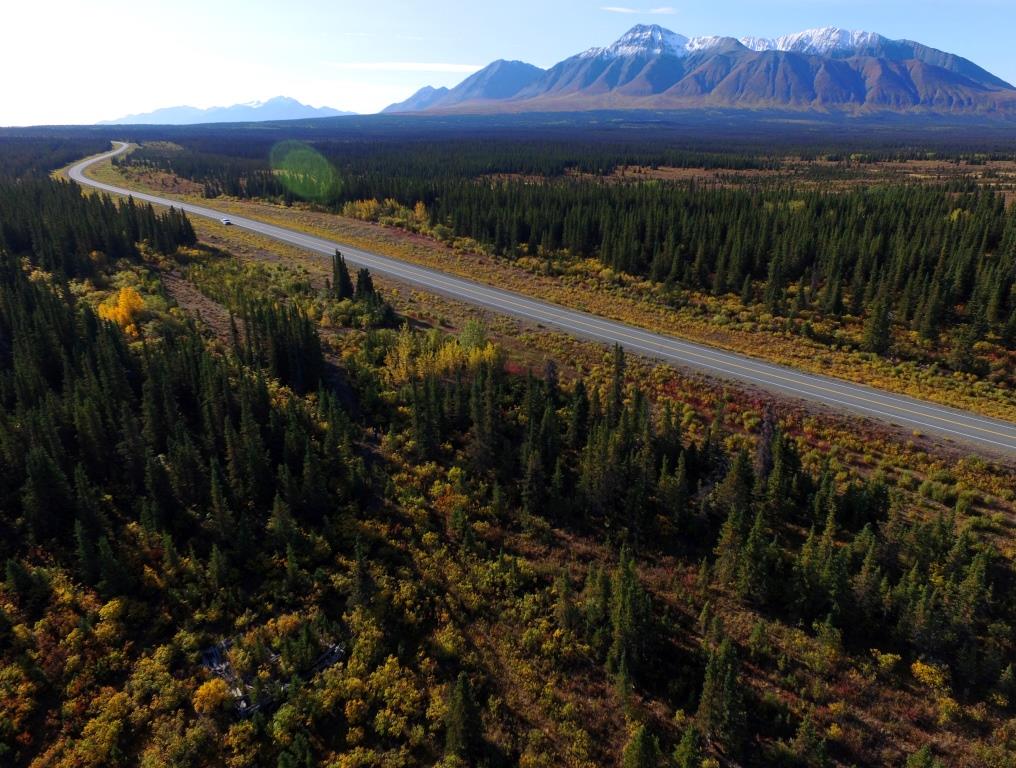
(Gord Allison photo)
Some details about this roadhouse were contained in a newspaper article in August 1909, after a survey crew overnighted there in May that year. The writer of the article said the roadhouse was abandoned and “inexpressibly filthy and full of vermin”. He said the roof was made of poles covered with earth and had a gentle slope, and described the interior as “like the others – a log cabin of one room, about 30 feet square, with one room partitioned off with cloth for a kitchen” and “about ten old bunks on the walls”.
Like a few sites, the Jarvis River roadhouse had a couple of photos taken of it by photographer E.J. Hamacher of Whitehorse. They are undated, but are likely from 1904 or ’05, when Hamacher dabbled in mining in the Kluane area.
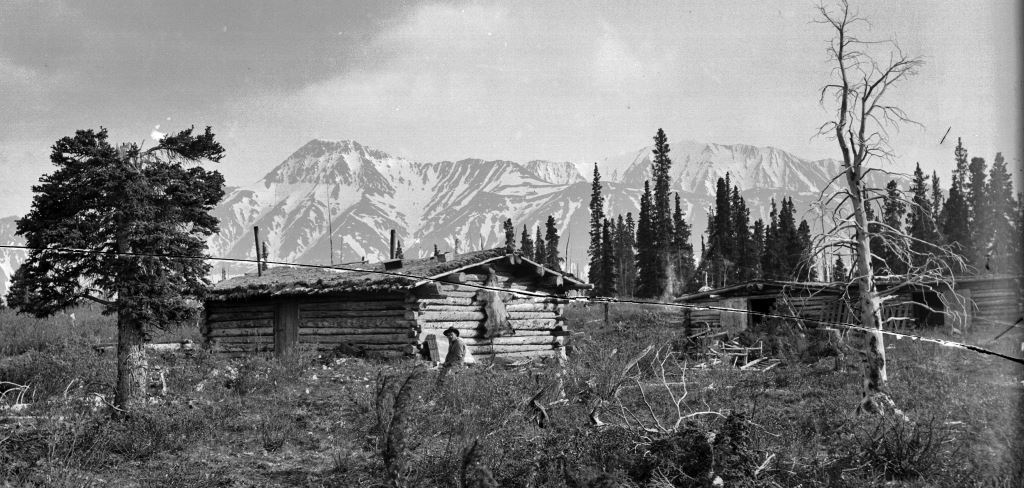
(Yukon Archives, E.J. Hamacher fonds (Hougen collection), Acc. 2002/118, #846 – photo has been cropped)
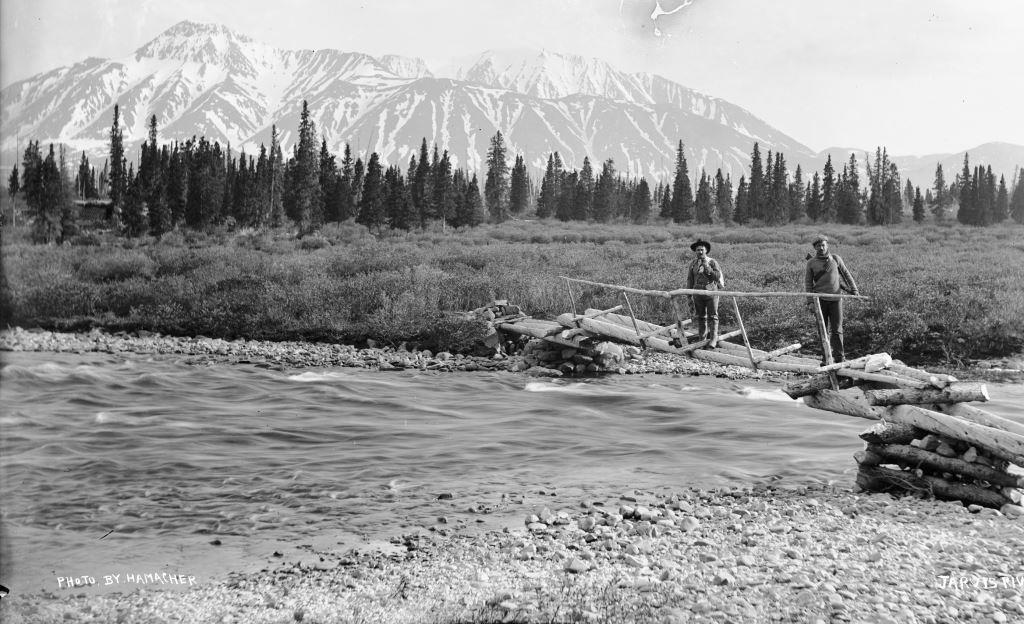
(Yukon Archives, E.J. Hamacher fonds (Hougen collection), Acc. 2002/118, #855 – photo has been cropped)
After 1909 there is no other information available about the Jarvis River roadhouse. Unlike some others that were removed or destroyed, it remained in place to eventually collapse and begin its journey to rotting away and returning to the earth.
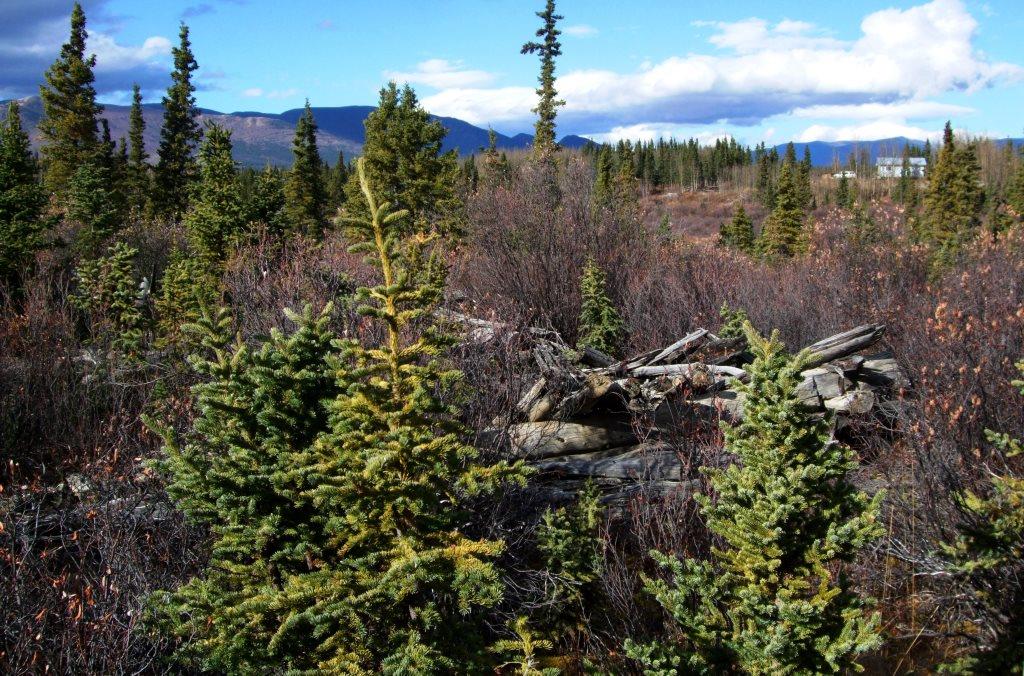
(Gord Allison photo)
A few newspaper articles in the late winter/early spring of 1904 referred to roadhouses and stores being built at “Kloo Lake”, at the junction of the trails to Ruby, Bullion and Kimberley Creeks. This location is not known, but it makes the most sense that is was somewhere in the vicinity of the south end of Kloo Lake. This may have been at or near the site of the Jarvis River roadhouse, but there is no information or evidence that has yet determined where these developments may have been, or even if they came to be. Future research may shed more light on this and a few other such mysteries in the area.
Kloo Lake
There is no known roadhouse site at Kloo Lake, the south end of which is less than a mile north of the Jarvis River roadhouse location. However, a number of references to roadhouses, hotels and stores at Kloo Lake require that it be mentioned here.
In Robert Coutts’ Yukon Places and Names book there is an entry for ‘Kloo Lake City’. It says this was “a small sawmill settlement” on the north side of Kloo Lake established in 1905 to supply lumber for the gold miners in the area. Where Coutts got this information is unknown, and I have no knowledge of a sawmill or settlement at the north end of Kloo Lake, though there was a small assemblage of buildings three miles north of the lake. The only sawmill I am aware of was near Frank Sketch’s trading post about half way along the west side of Kloo Lake.
The only other reference I have seen to Kloo Lake City is a Whitehorse newspaper article in April 1904 that said “Kloo Lake City and Bullion City are growing rapidly …”, with no further details. Other articles in the late winter and early spring of 1904 mentioned developments at a place referred to only as ‘Kloo Lake’, said to be at the junction of the trails to Ruby, Bullion and Kimberley Creeks. One article said that two roadhouses and two general merchandise stores were located there, and a hotel liquor licence was issued to H. (Henry) Baxter, a hotel keeper from Whitehorse. In April 1904 Ludger Roy and Edward St. Arnaud, along with Mrs. St Arnaud as the chef, ran advertisements in the Whitehorse newspaper for their ‘Kloo Lake Hotel and Restaurant’.
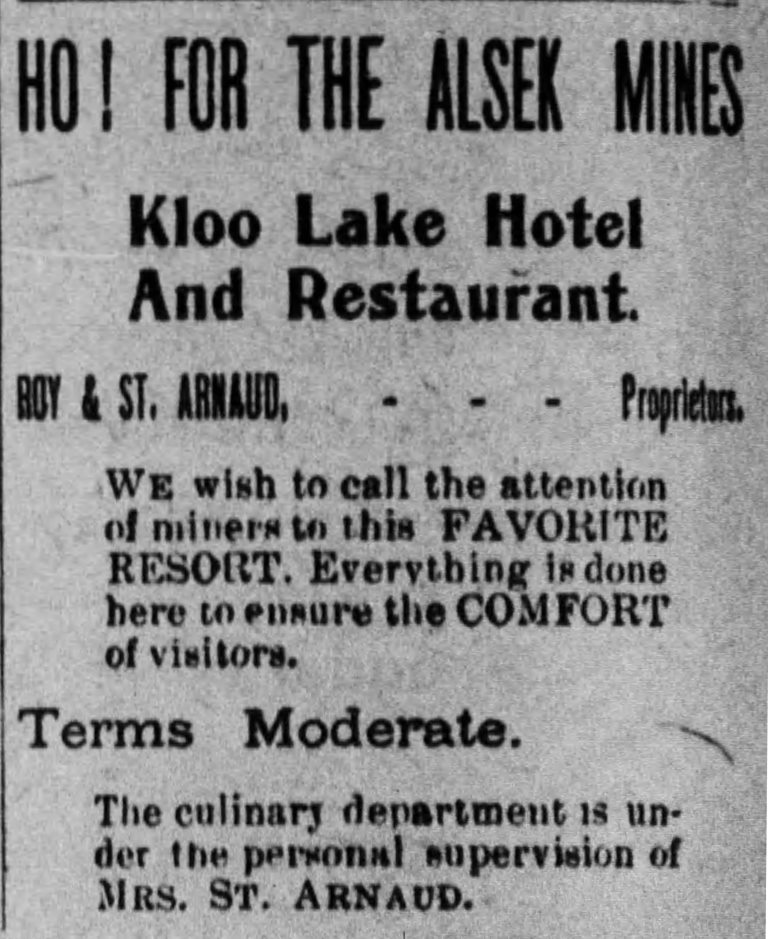
(The Whitehorse Daily Evening Star, 9 April 1904)
The location of the junction of the trails to Ruby, Bullion and Kimberley Creeks, the supposed site of ‘Kloo Lake’, is not known. It would seem to make the most sense that it was somewhere around the south end of Kloo Lake, perhaps at or near the site of the Jarvis River roadhouse. This is one of a few unsolved history mysteries in the Kloo Lake area that future research may shed more light on.
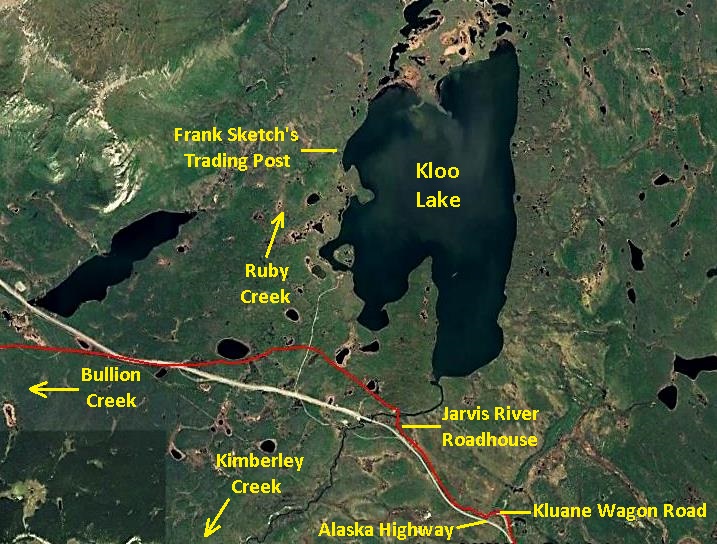
(Google Earth)
Boutellier (mile 140)
A roadhouse was apparently located at Boutellier Creek, 14 miles northwest of Jarvis River along the Kluane Wagon Road, and now about four miles to the southeast of Alaska Highway kilometer 1634. An old building at the creek crossing is relatively large at about 30 feet square, which seems to be a typical size for a roadhouse in this area. I have found no documentation of this roadhouse and only know of it as part of local history lore and reference to it by a knowledgeable elder.
In a 2003 interview, late elder Josie (Jacquot) Sias of the Kluane First Nation said that when she was a child in the 1930s, her family would camp out at some roadhouse sites on trips from Burwash Landing to Whitehorse for supplies. This is likely because they were somewhat developed spots with firewood, water, and feed for horses (when they travelled by wagon). One of the sites Josie mentioned was Boutellier Creek.
In a photo taken in 1942 of a building at the crossing of Boutellier Creek when the Alaska Highway initially used this portion of the Kluane Wagon Road, there are only half-height walls showing. This does not appear as a collapsed building, as there are no roof remnants inside or outside of it. It either had not been completed, had the roof and upper parts of the walls removed for log and/or firewood salvage, or had a canvas top as some others did. Whatever existed there, 80 years after this photo the building looks much the same, other than it has sunken lower toward the ground as the log walls slowly rot.
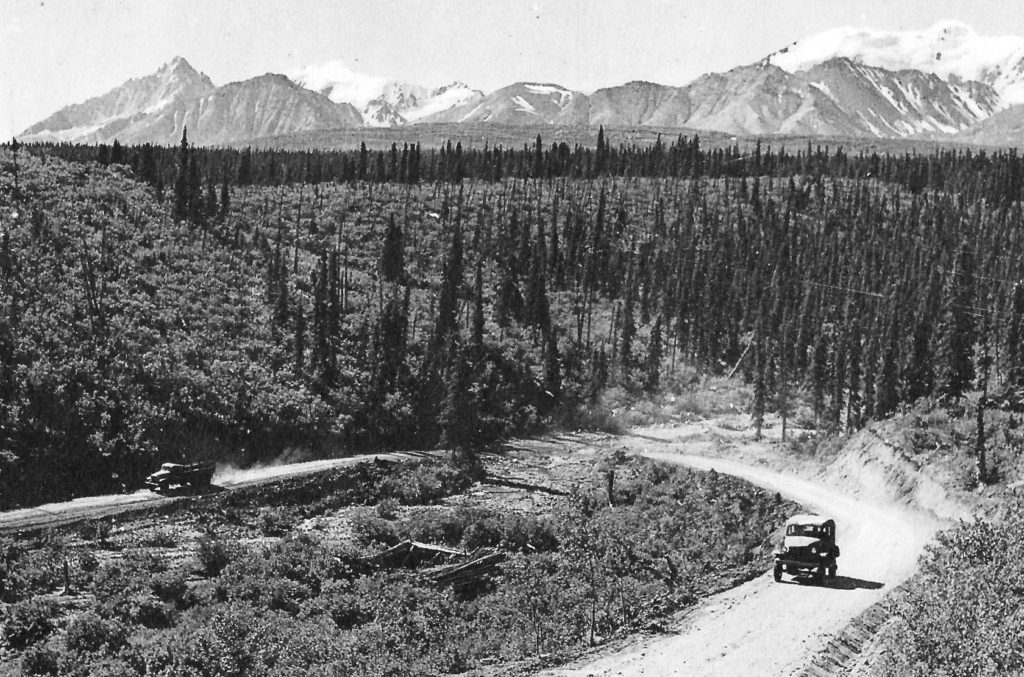
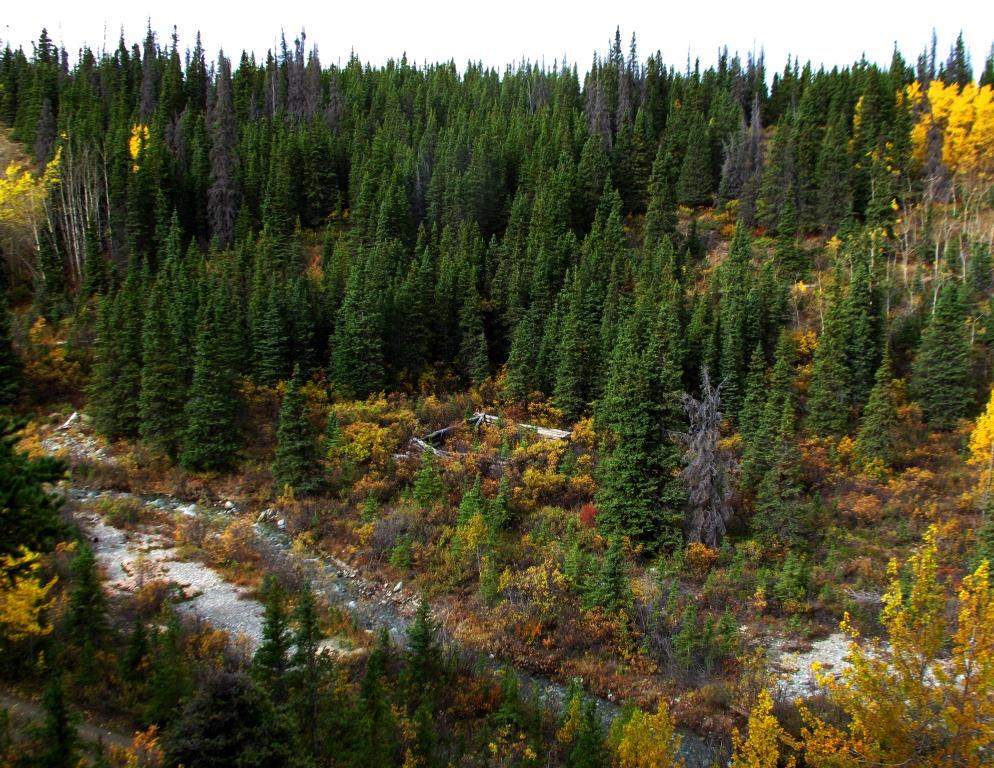
(Gord Allison photo)
Silver City (mile 148)
The Kluane Wagon Road terminated at Silver City, near the southeastern corner of Kluane Lake and accessed by a side road near kilometer 1636 of the Alaska Highway. It soon after became a jumping off point for travel to gold creeks feeding into the nearby Slims River, later to creeks near Burwash, and still later to the upper White River and Chisana River (Alaska) areas. Silver City became a small community with a North-West Mounted Police post, a mining recorder office, a homestead, a handful of resident cabins, and a reported roadhouse.
There are only a few references to a roadhouse at Silver City and its location is unknown. It is therefore not included as one of the 15 roadhouses identified for this article. Further research will hopefully help to tell this story.
Roadhouses of the Kluane Winter Road to Cultus Bay
Harry Chambers’s 1908-09 winter road from Marshall Creek to Cultus Bay on Kluane Lake came into greater prominence with the Chisana gold rush that started in 1913. The Whitehorse Board of Trade’s promotional pamphlet “Shushanna Goldfields” included a list of roadhouses to be found along this route.
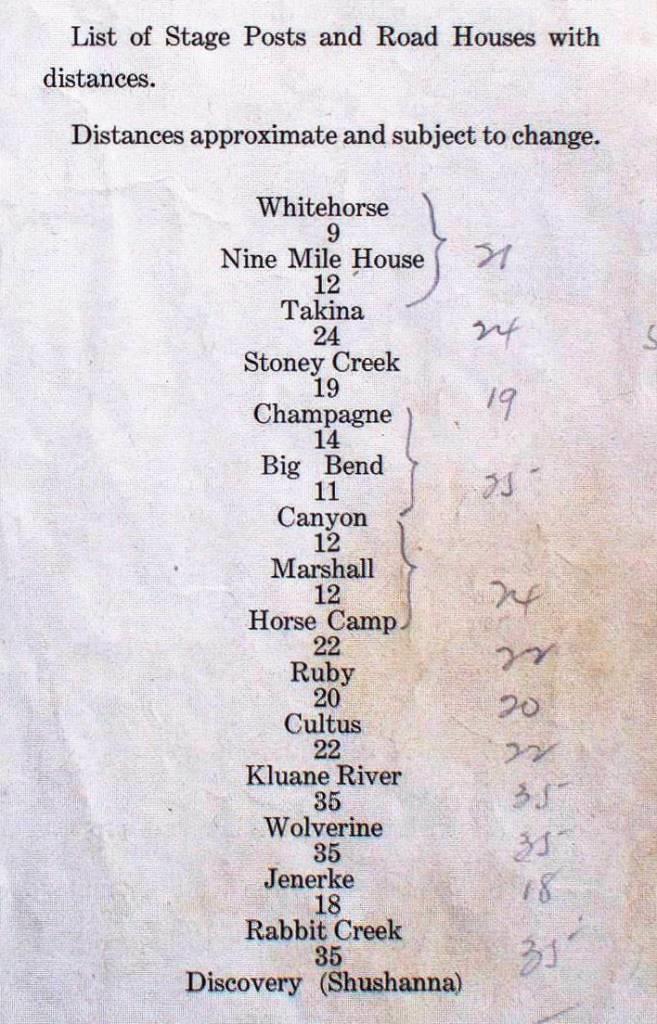
Winter Road in a 1913 promotional brochure.
(Yukon Archives, Whitehorse Board of Trade, “Shushanna
Goldfields”, PAM 1913-0013)
The first eight roadhouses listed, up to and including Marshall Creek, were on the Whitehorse-Dawson Overland Trail and the Kluane Wagon Road. The next three, Horse Camp, Ruby and Cultus, were on the winter road to Kluane Lake, and the rest were beyond (west of) Kluane Lake on the route to the White River and Chisana (Shushanna) country.
On the winter road from Marshall Creek to Kluane Lake, Horse Camp was not a known location, but a possibility has been identified for it. Ruby’s location is questionable and Cultus has two possible locations.
Horse Camp
The Whitehorse Board of Trade pamphlet list of roadhouses is the only place I have seen the name ‘Horse Camp’ for a roadhouse in the Kluane area. Like Summit House on the original trail, there is a potential solution to the location of Horse Camp that may never be able to be confirmed one way or the other.
In June 2019, in the course of wildfire operations, Haines Junction resident Shane Oakley found an old building in the bush that he had previously heard about. He brought it to my attention and we went to the site on the northern edge of the Shakwak Valley about eight miles north-northwest of Haines Junction. I was very surprised to see such a large building, with an addition, in that relatively obscure location.
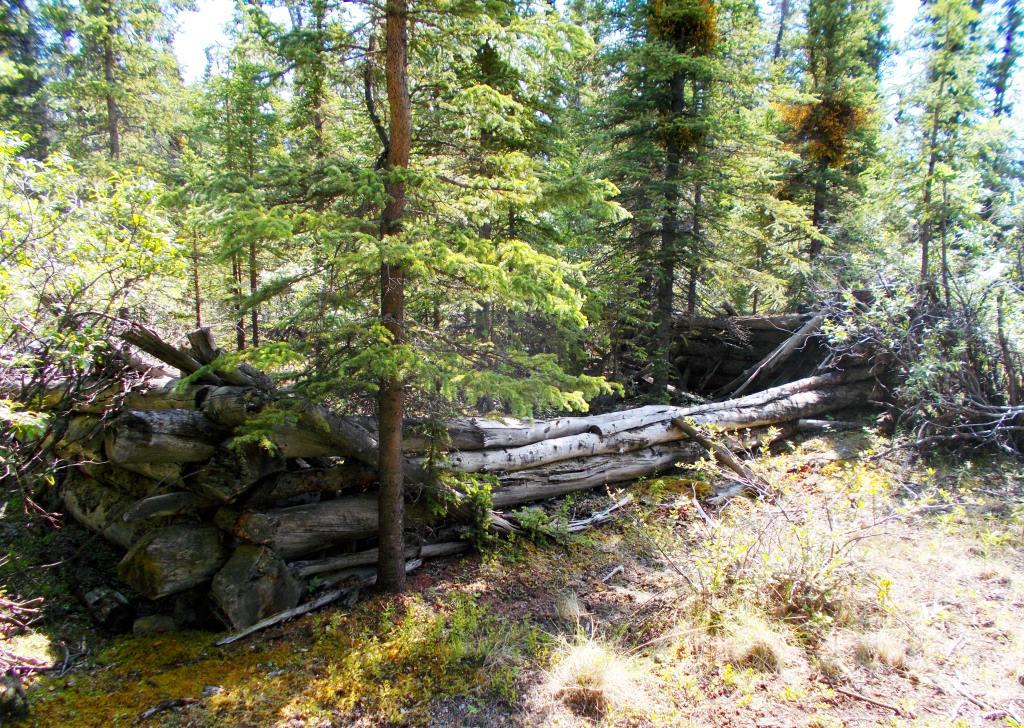
(Gord Allison photo)
The building was well off of any trail or road I was aware of and it was very puzzling. Nothing made sense until I connected it with the Whitehorse Board of Trade pamphlet for the Chisana gold rush. The route that the Board was promoting was a winter road, which wouldn’t have left much evidence of its existence, especially more than 100 years later.
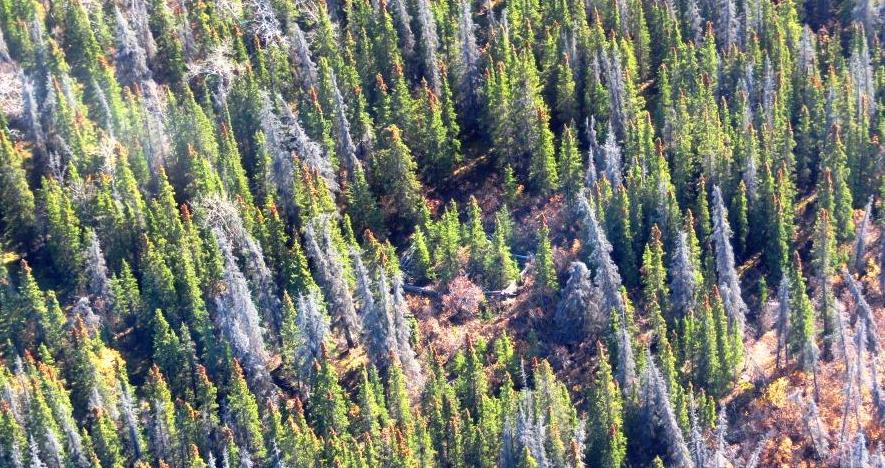
(Owen MacKinnon photo)
Given the likely route of Harry Chambers’ winter road, the stated mileages from Marshall Creek to Horse Camp (12 miles) and from Horse Camp to Ruby (22 miles) fit very well with the location of this building. I therefore am suggesting that the Horse Camp shown on the Whitehorse Board of Trade roadhouse list is the most plausible explanation for the large building reported by Shane Oakley.
Ruby
On the Cairnes 1914 map showing the winter road to Kluane Lake, the plotting of a roadhouse in the general vicinity of Ruby Creek is all there is to go on for the ‘Ruby’ that is listed in the Whitehorse Board of Trade pamphlet. It might be assumed this is Ruby Camp, a small settlement near the lower (south) end of Ruby Creek that sprang up for a brief period during the gold rush into this area in 1903. It had a roadhouse, store, North-West Mounted Police post and post office, but none of these lasted once the mining activity began to decline in 1905.
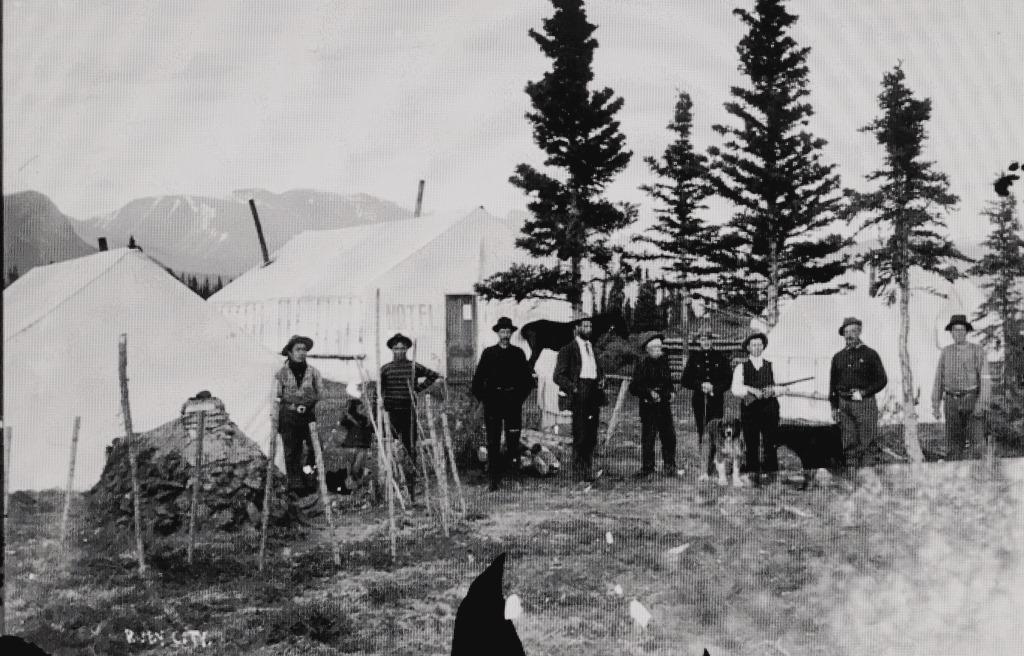
(Yukon Archives, E.J. Hamacher fonds (Hougen collection), Acc 2002/118, #145)
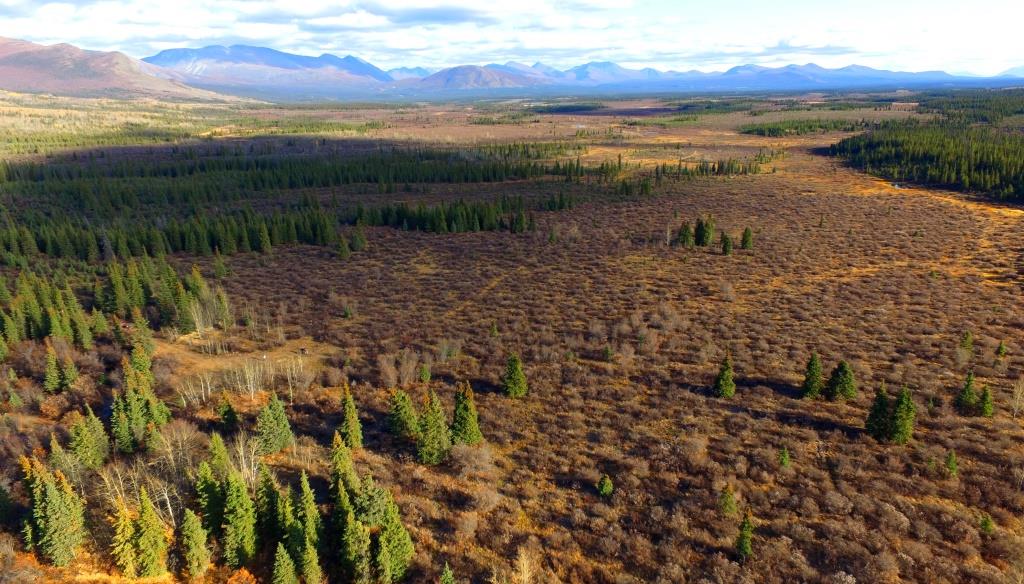
(Gord Allison photo)
There is no information in the 1913 Board of Trade pamphlet or other known sources to determine if a new roadhouse was established at the Ruby Camp site or another location during the Chisana gold rush. In this respect I cannot say that I have documented with any certainty the location of ‘Ruby’.
A previous article about Ruby Camp provided more information about this site. A link to it is at Ruby Camp.
Cultus
There are two known building locations in the Cultus Bay area, both of which may be possibilities for the roadhouse called Cultus in the Whitehorse Board of Trade pamphlet.
In October 1913, a Burwash Creek miner named Melvin Clark made application for five acres of land on the shore of Kluane Lake for roadhouse purposes. The location was a mile and a half north of Cultus Bay, and the sketch accompanying his application showed that it was where the winter road came out to Kluane Lake. His application was approved in January 1914.
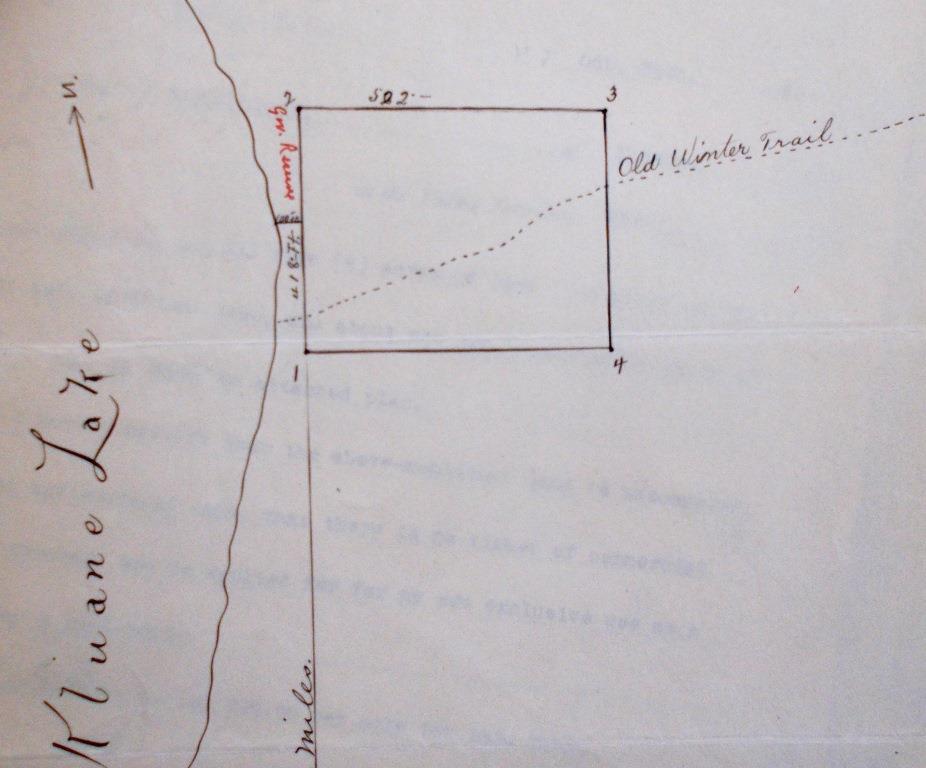
(Library & Archives Canada, RG85 Vol. 1838, File 112099)
By February 1914 Clark had built a roadhouse at the site, which may be an old log building that is in the vicinity of the land he applied for. It is relatively large and still standing quite firm with a fairly intact roof, which is not common for a sod-roofed log building over 100 years old. It has at least seven apparent bunks built along the walls, a good indicator of a possible roadhouse, and a separate section that may have been for a kitchen.
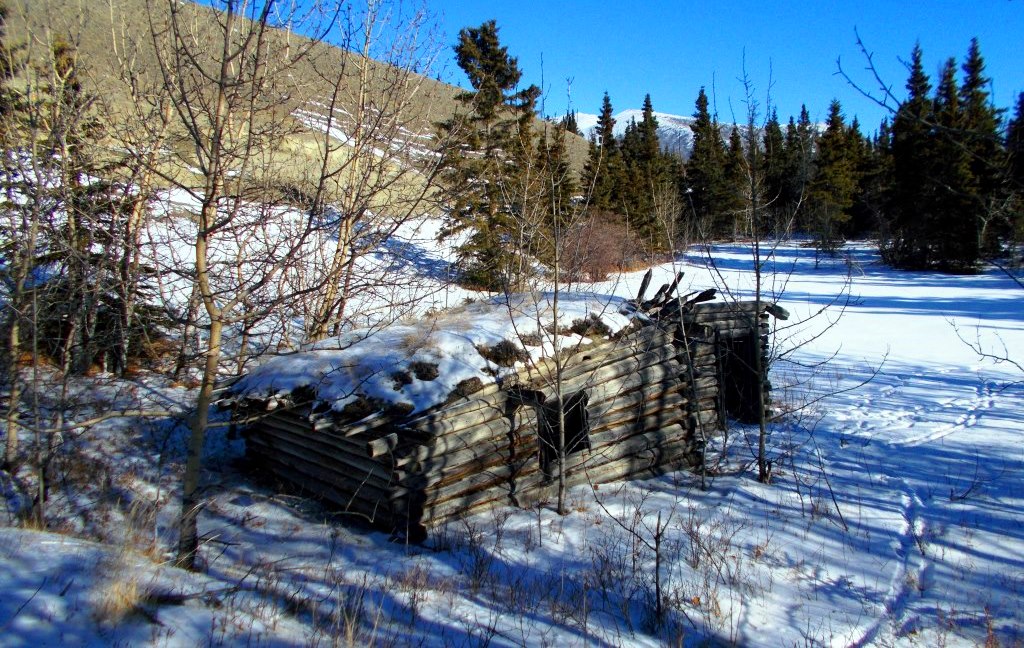
(Gord Allison photo)
It is not known if Clark actually operated a roadhouse at this location, but his land file indicates that by the following January of 1915 he had gone elsewhere, likely because the Chisana gold rush activity had dried up. That September he confirmed that he was no longer interested in the land and his application was cancelled.
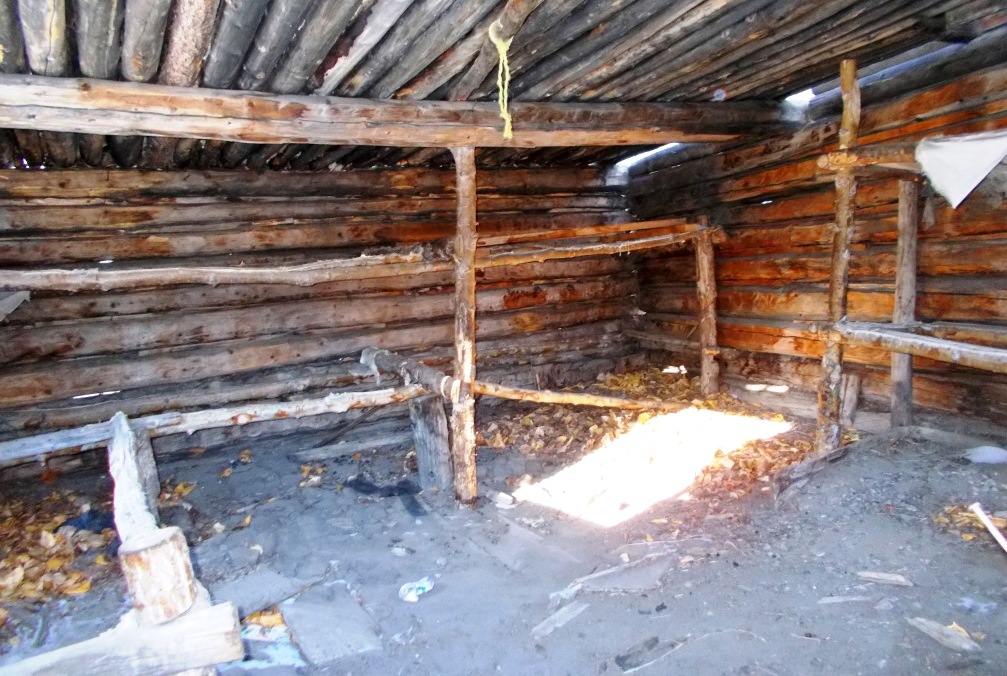
(Gord Allison photo)
If the building still standing at Clark’s location was his roadhouse, it is the most complete such structure that exists along the routes covered in this article. It was built very well and may have had some maintenance, including a new roof or two, in the years following by other people for other purposes.
In October 1914, when the Chisana gold rush was still on but waning, a former Whitehorse baker named Robert Newson (sometimes shown as Newsom) applied for three acres of land south of Clark’s near the northeast corner of Cultus Bay. Newson had a roadhouse on Burwash Creek and said that the land at Cultus would be used for a roadhouse and “trading station”.
The sketch accompanying Newson’s application shows three buildings on the site, at least one of them belonging to Harry Chambers, who may have built it in conjunction with his winter road construction project five years previously. Chambers seemed to have business interests everywhere in the Kluane region, and he was likely in some sort of business arrangement with Newson in the roadhouse endeavor.
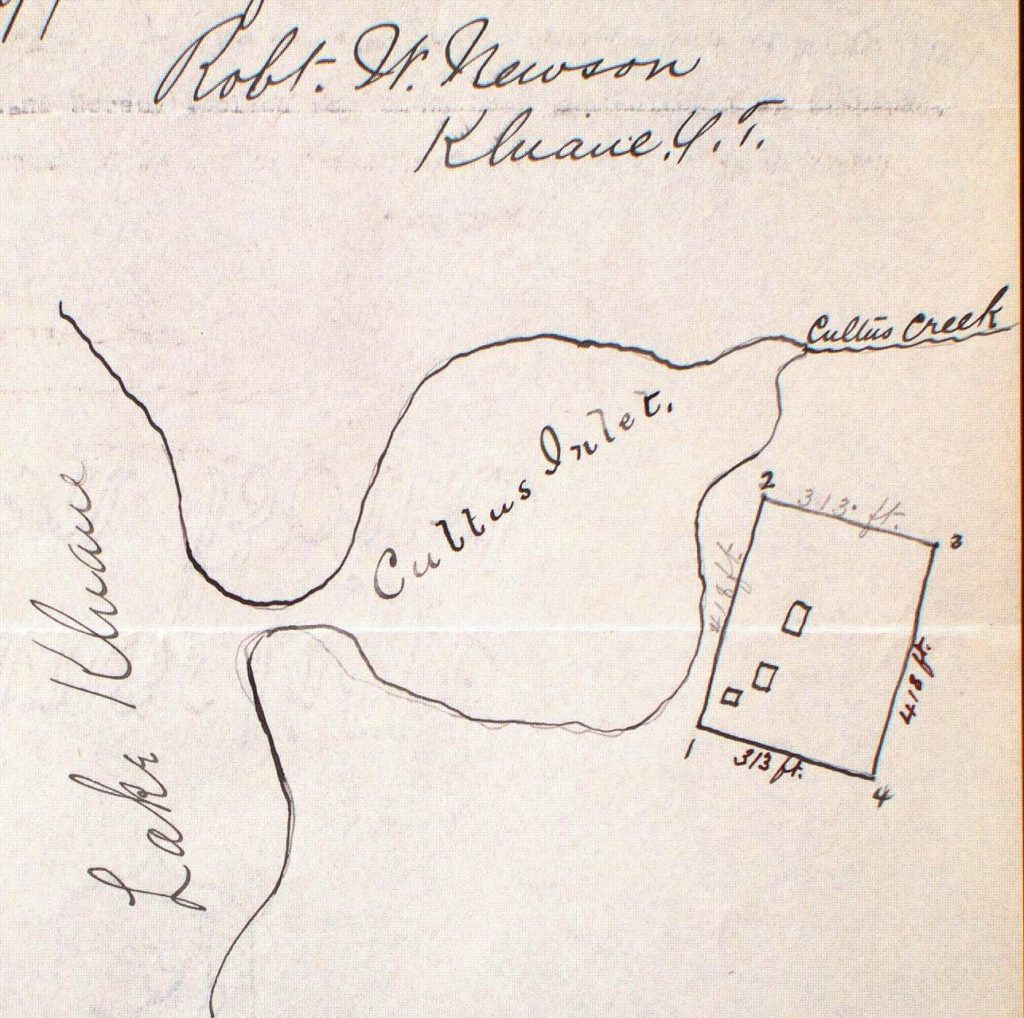
(Yukon Archives, GOV 1962, File 929)
It is a question why Newson wanted a roadhouse in the Cultus area within a mile and a half of Clark’s. Perhaps Newson already knew that Clark was not going to continue operating his roadhouse (if he ever did). What is also not known is if the Whitehorse Board of Trade pamphlet’s Cultus location on its roadhouse list was referring to only one or both of these roadhouses.
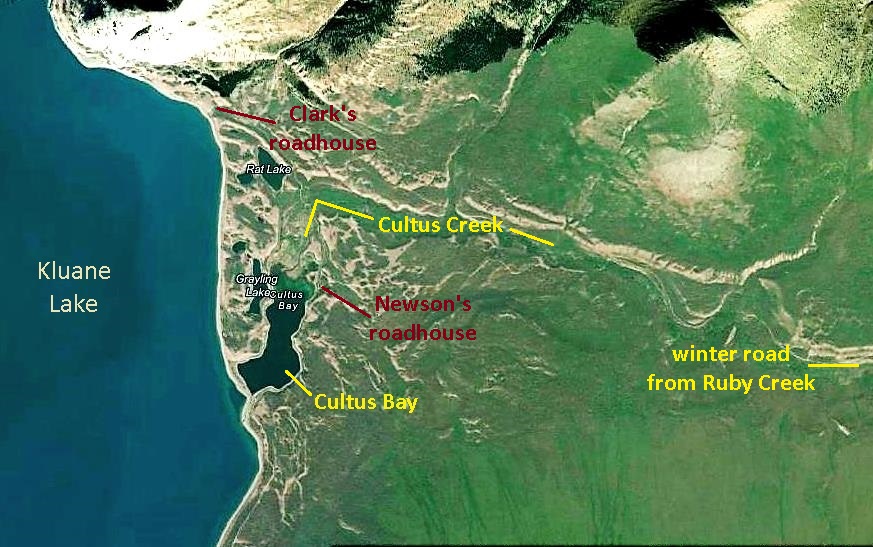
(GeoYukon viewer)
The last reference to Cultus roadhouse was in late February 1915, when a large group of men of the Kluane area gathered there to undertake a 300-mile round trip with dog teams to Whitehorse. Their reason was to vote in the Yukon territorial election (and make a strong point of protest) after recently learning that there would no longer be a Kluane polling station. Since Robert Newson was part of the group but Melvin Clark was not, it is assumed the gathering point was Newson’s roadhouse.
It does not appear that Newson operated his Cultus roadhouse for much longer. By the summer of 1915 he must have vacated his Cultus home because he was by then the Kluane mail carrier for Harry Chambers, who held the mail delivery contract.
Today the site of Newson’s roadhouse is private property. There are old cabins there, but whether any of them date back to the roadhouse time of 1914-15 or earlier is not known.
Summary
The Kluane area roadhouses were established by entrepreneurs who invested time, money and effort in trying to make a livelihood from the opportunity afforded by the Kluane and Chisana gold rushes. Even though most of the roadhouses did not operate for long, they played an important role in supporting the travellers and the activities associated with these gold rushes and subsequent developments.
My previous article about the Kluane Wagon Road focussed on its history and construction, as well as the locating of the surveyed road on the ground. What was not included was the story of the roadhouses that were built along the wagon road, a story that is now approaching 120 years old. Information about the human aspect of the roadhouse operations is scarce, but perhaps over time some will emerge to help tell their story more fully. In the meantime, this article is my attempt to document the roadhouses with what is available and the remnants that still exist on the land.
Links to related articles:
©Yukon History Trails – Gordon Allison 2022